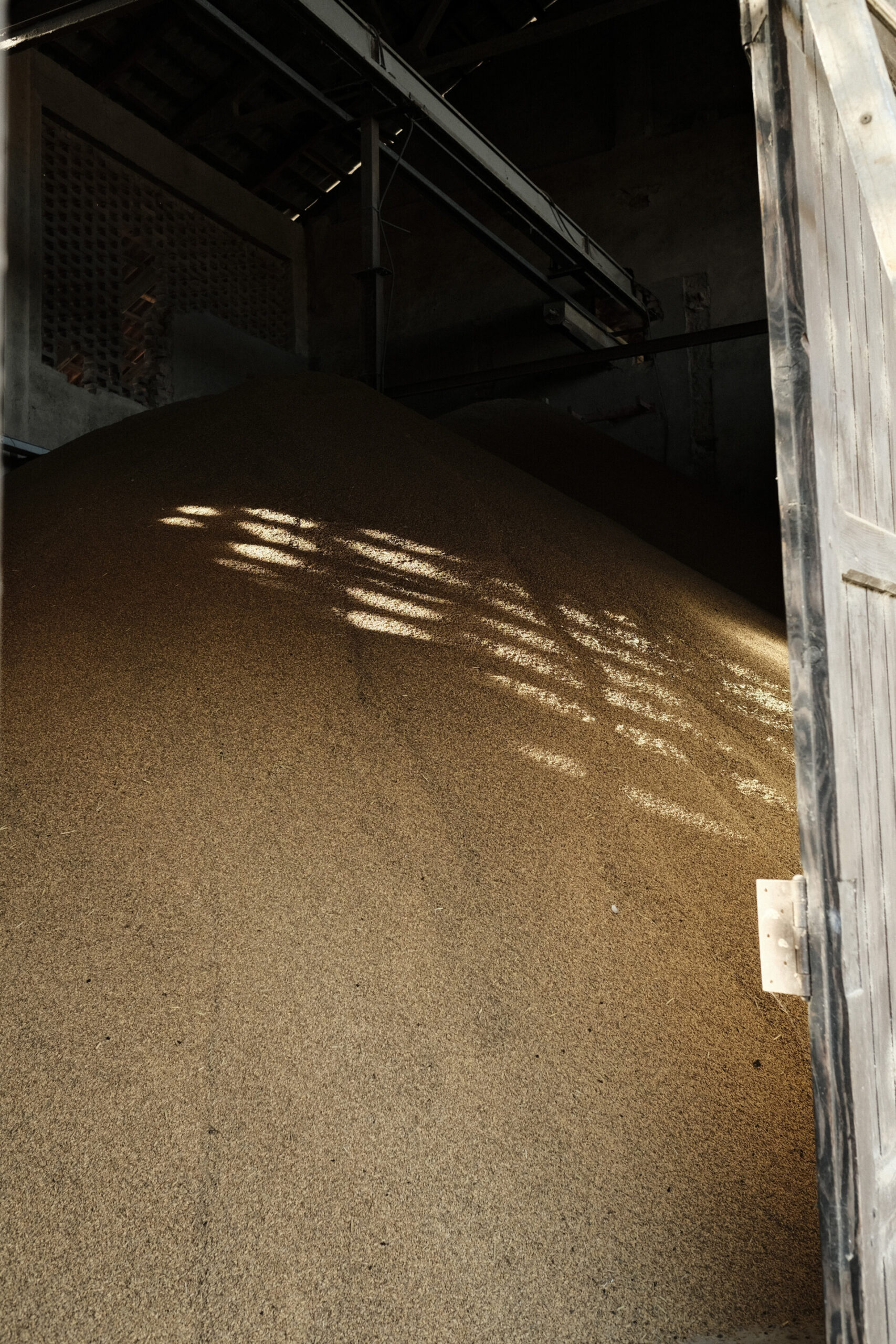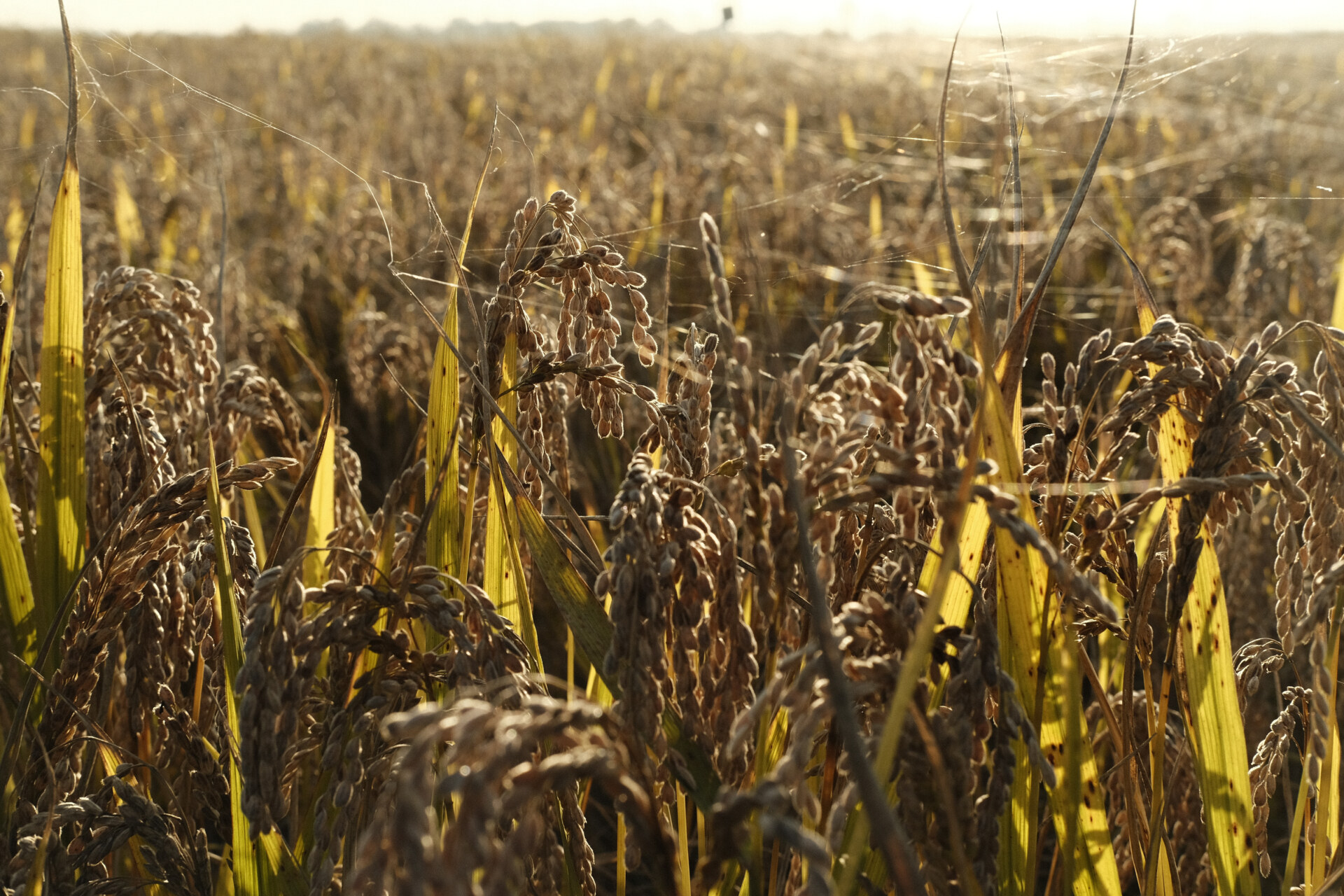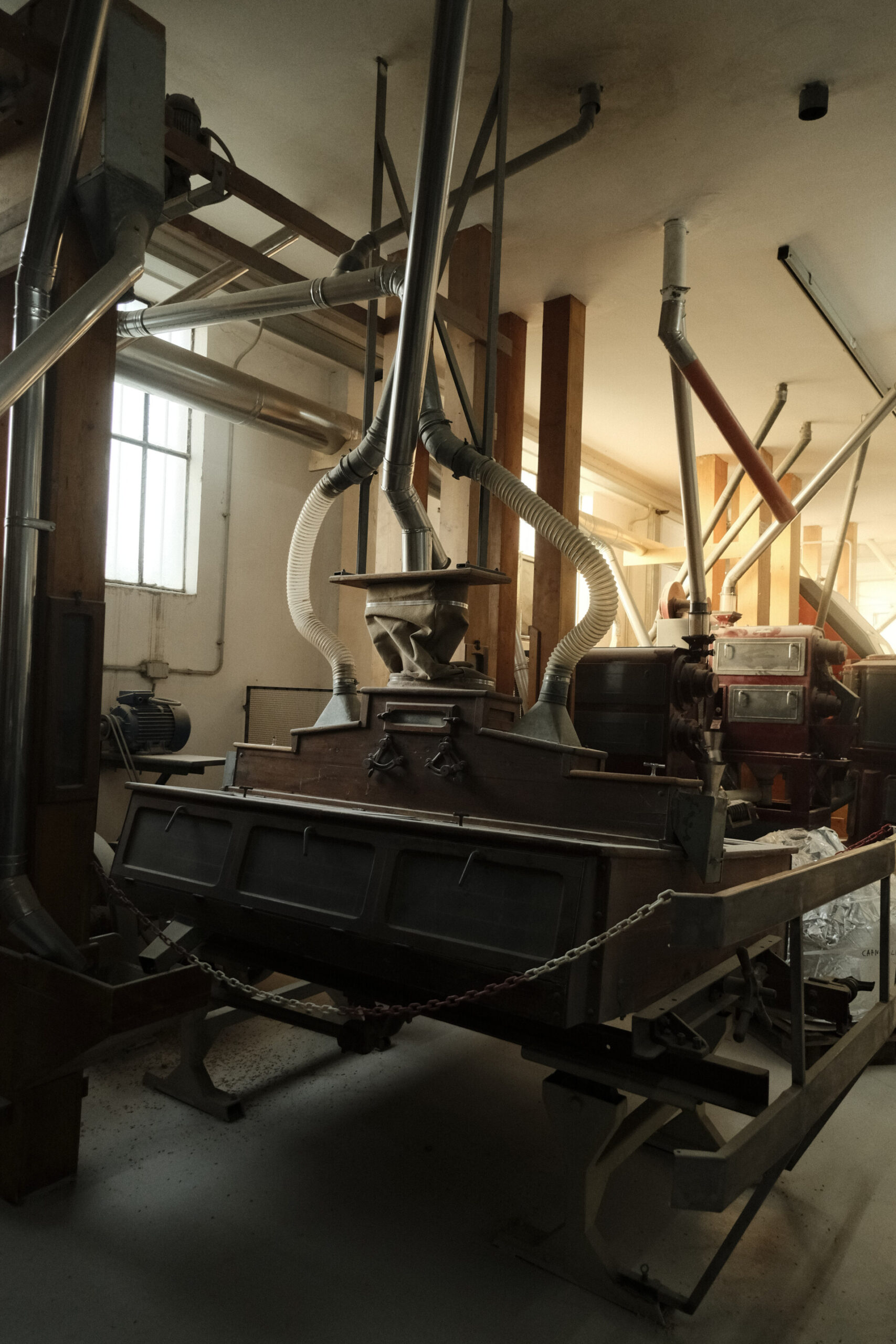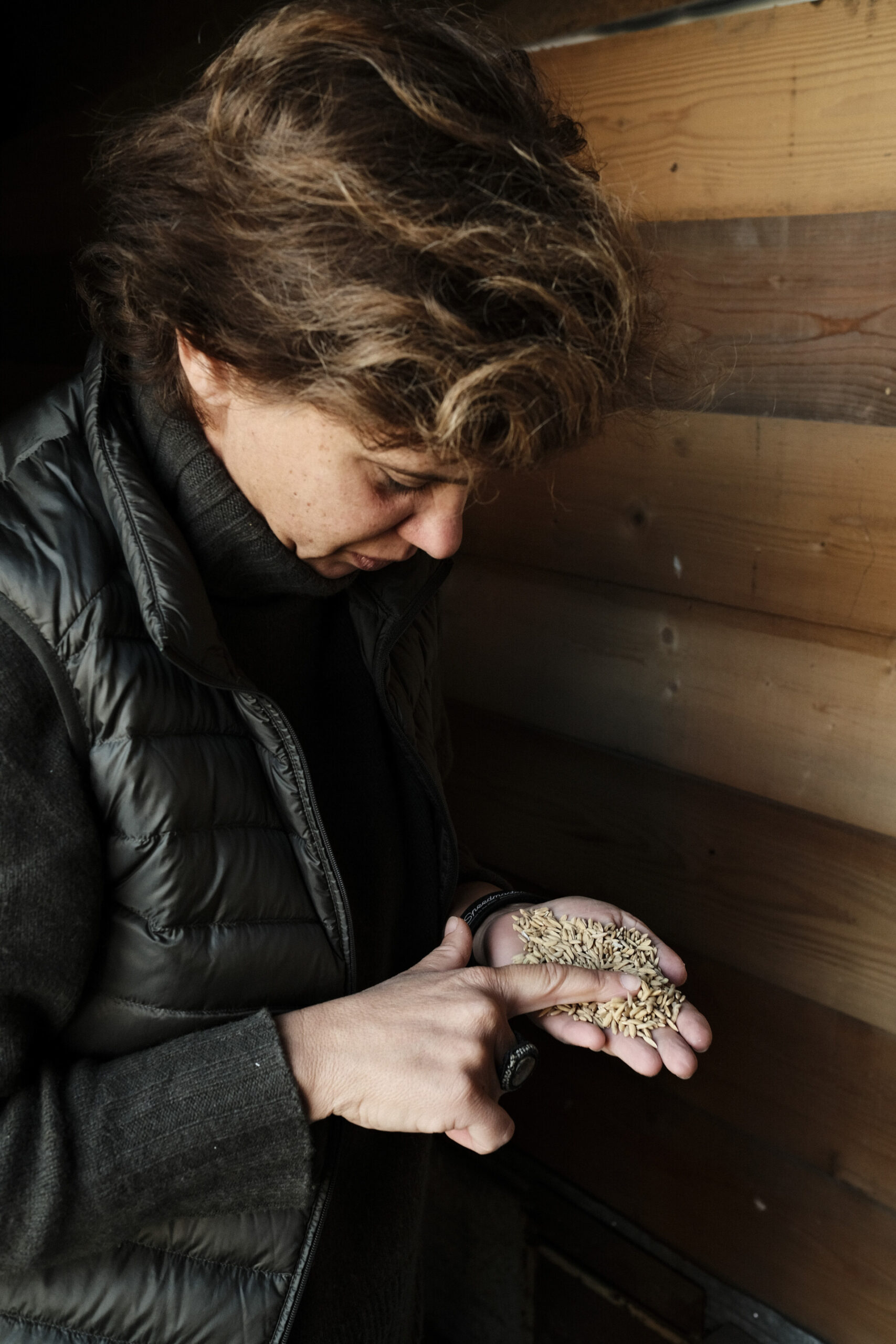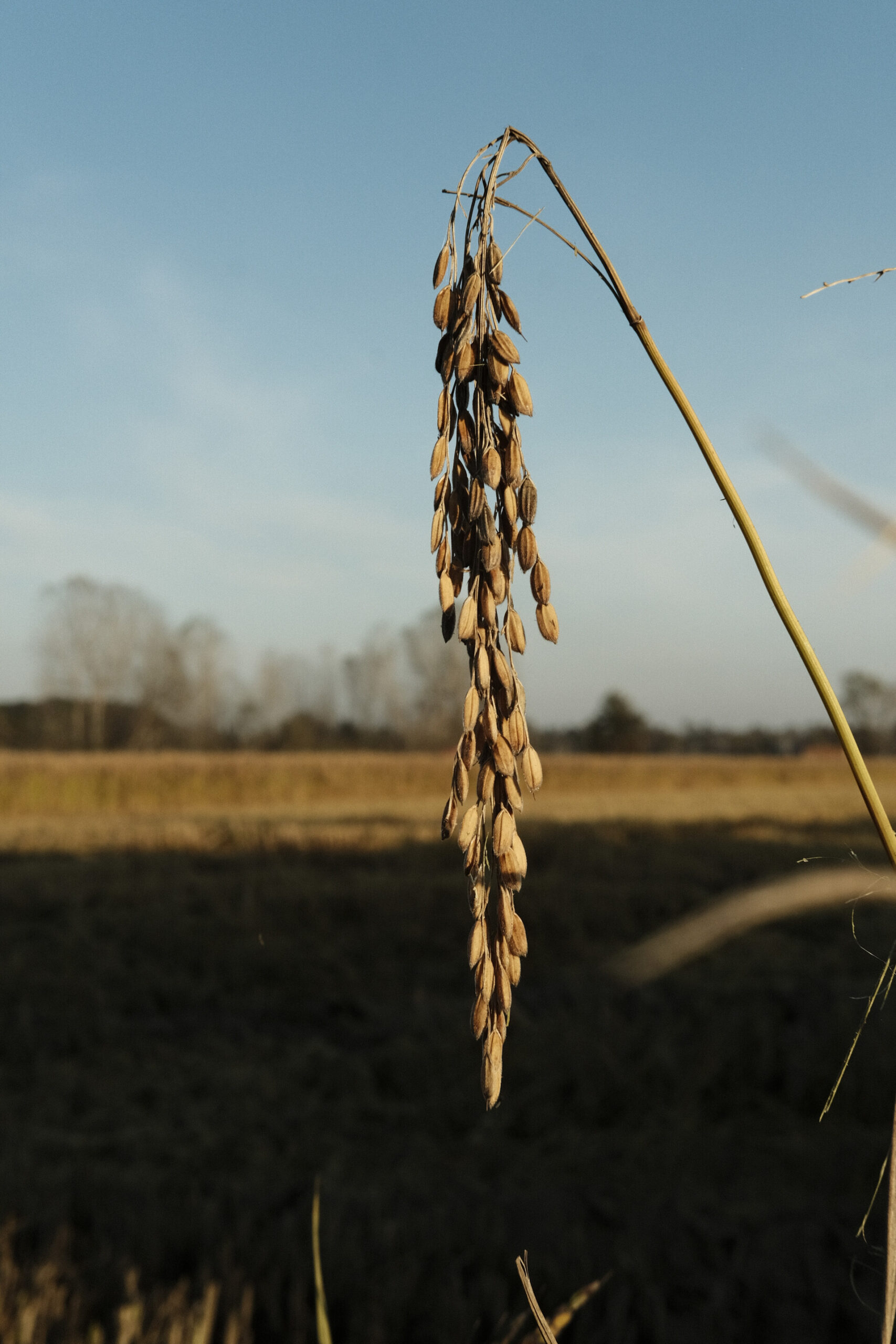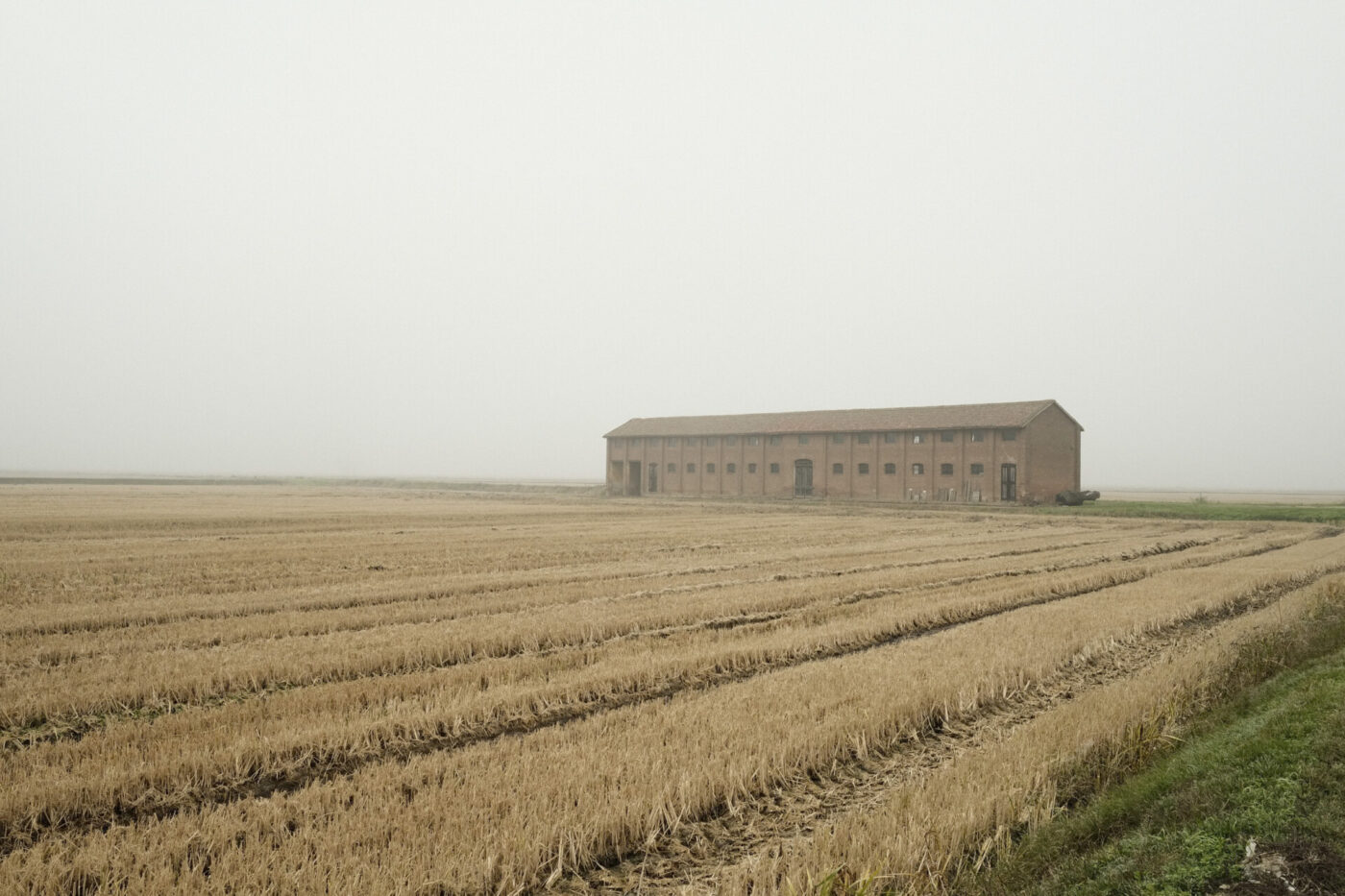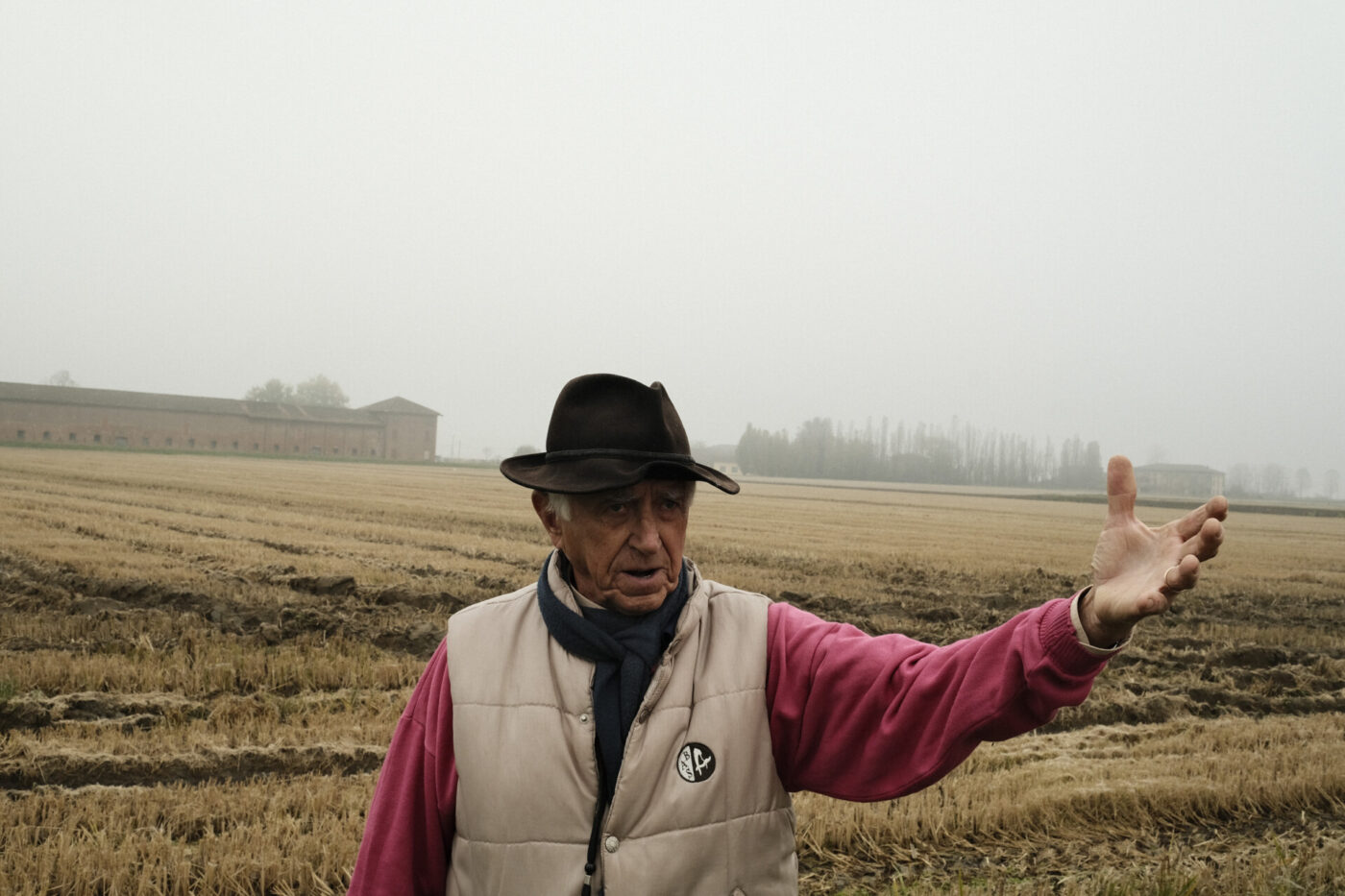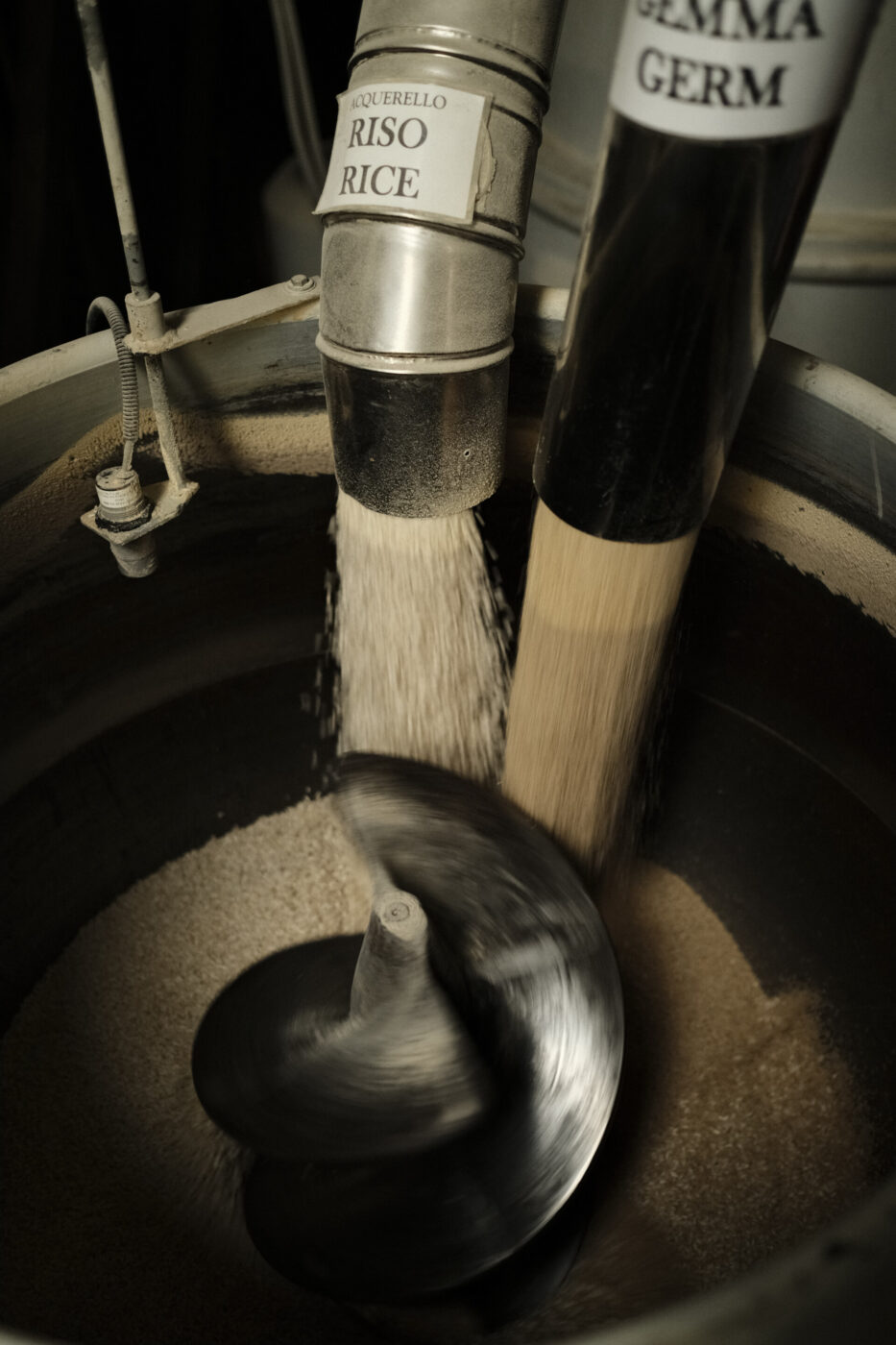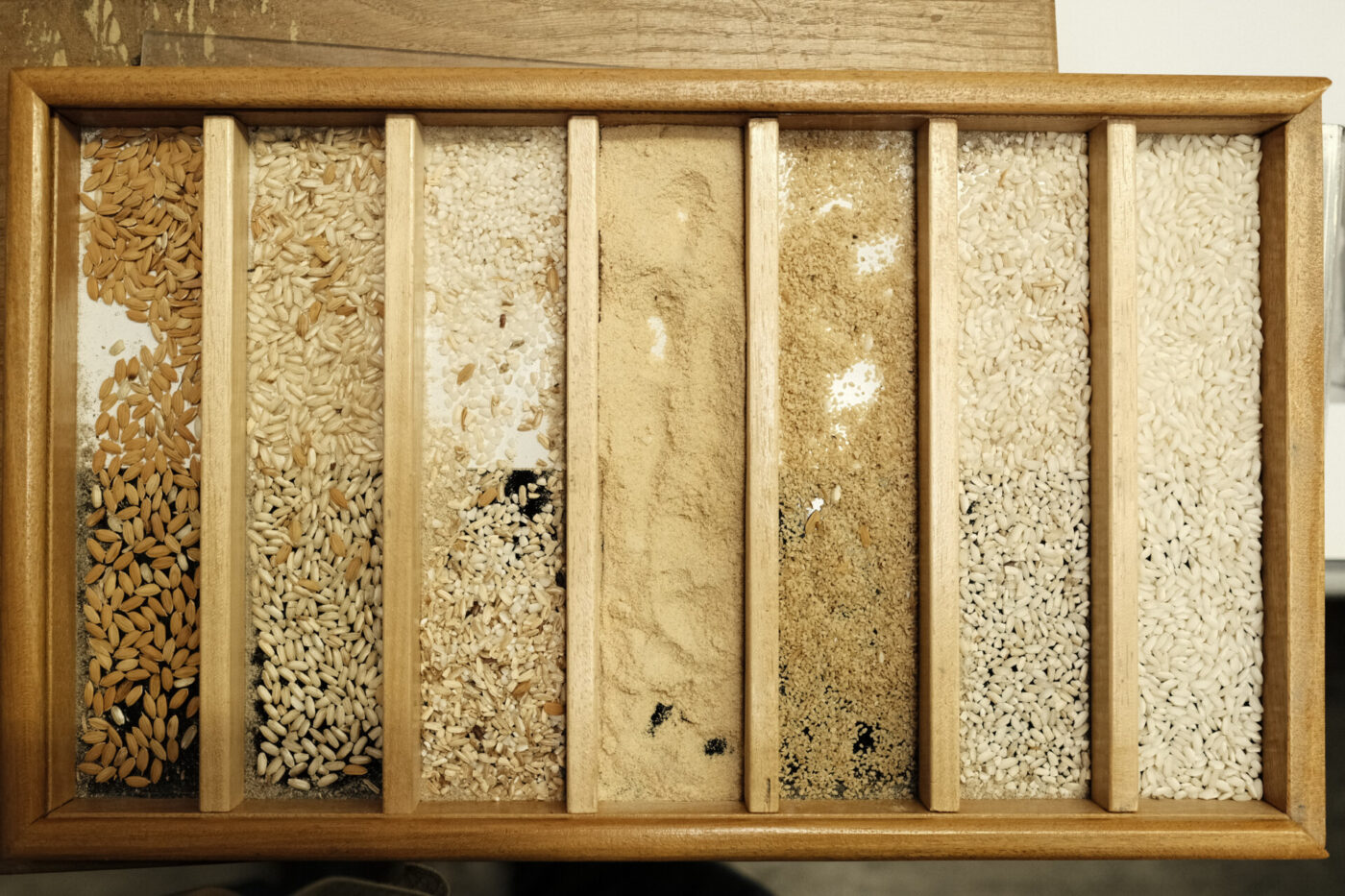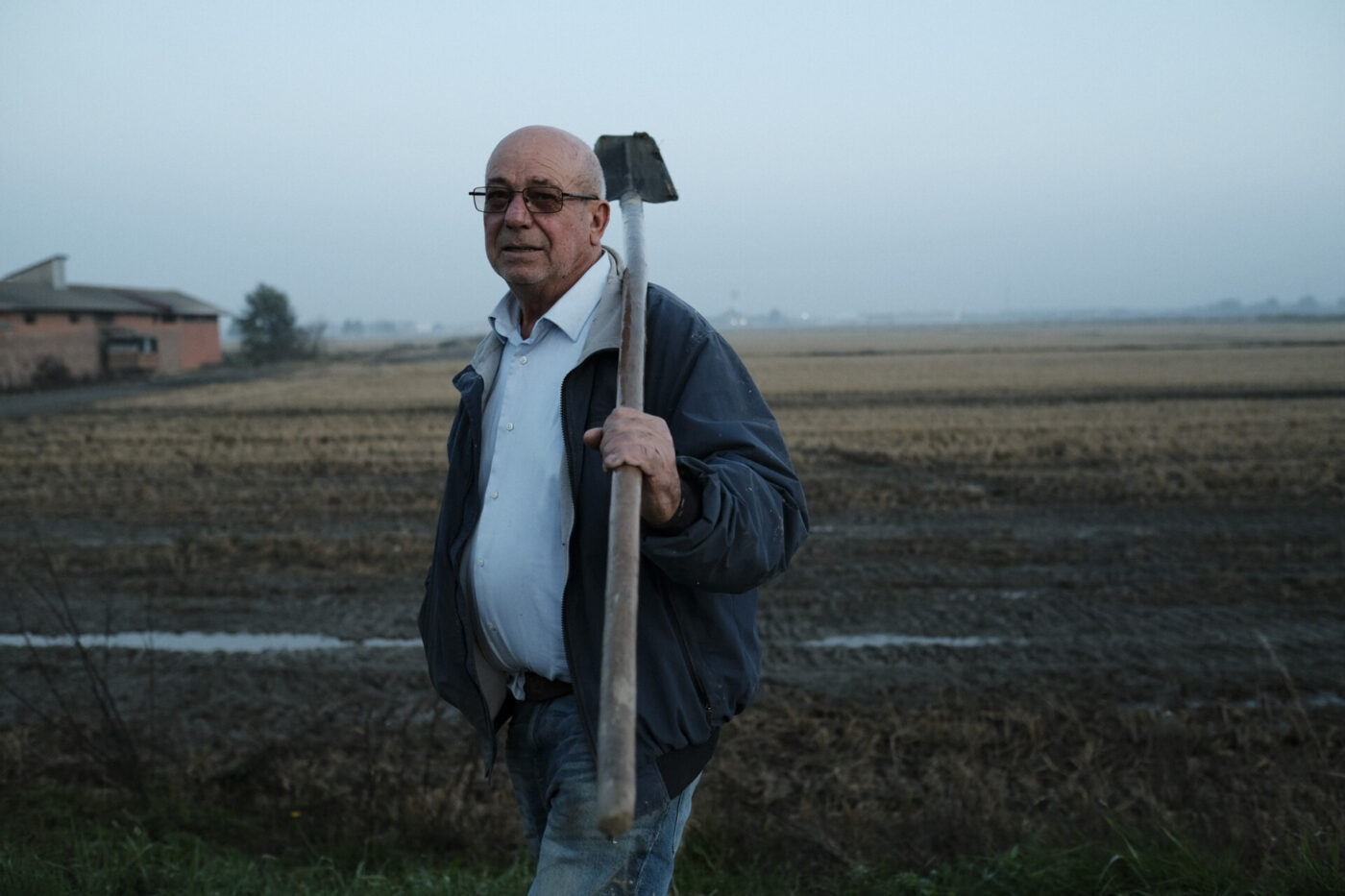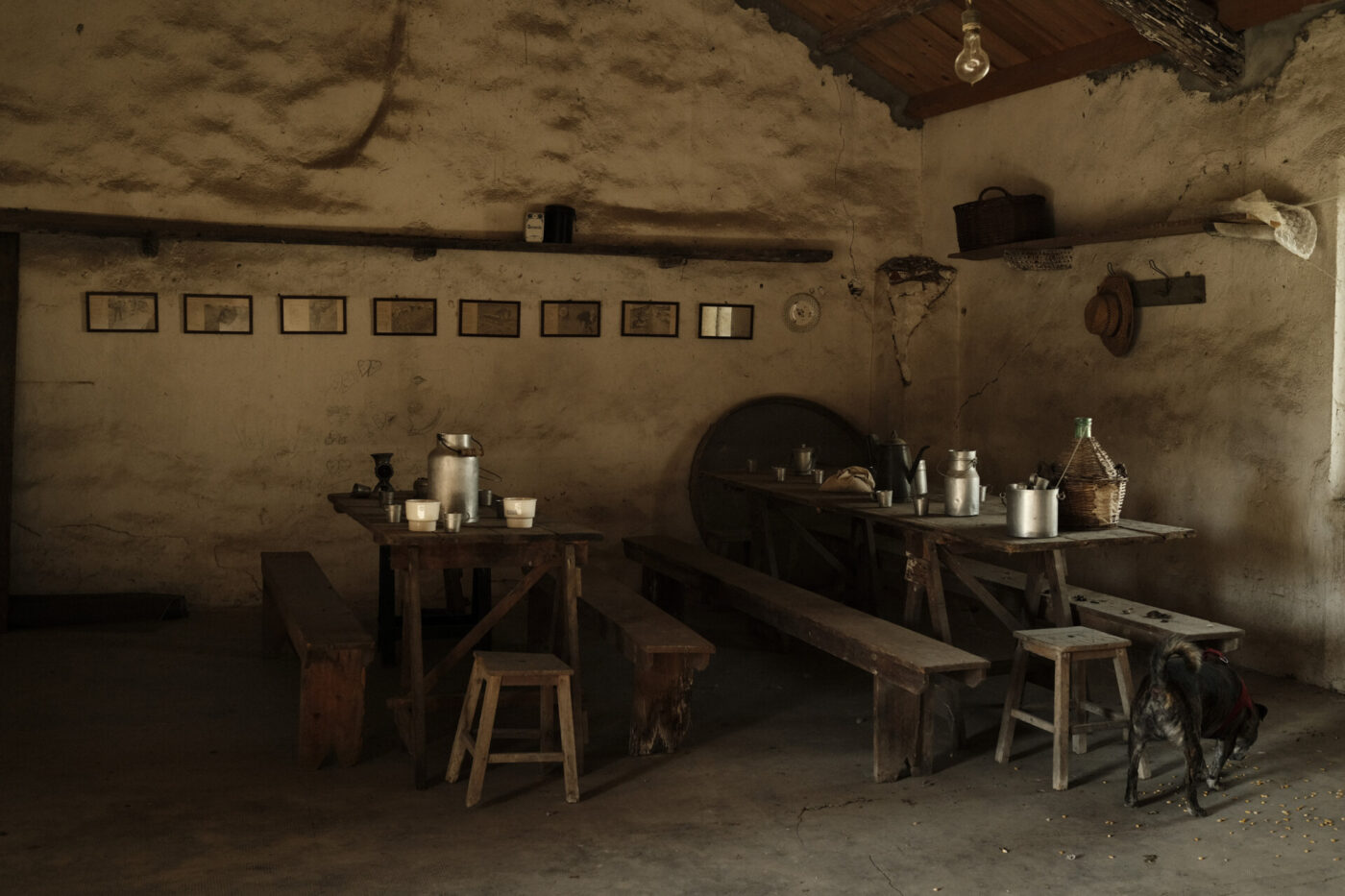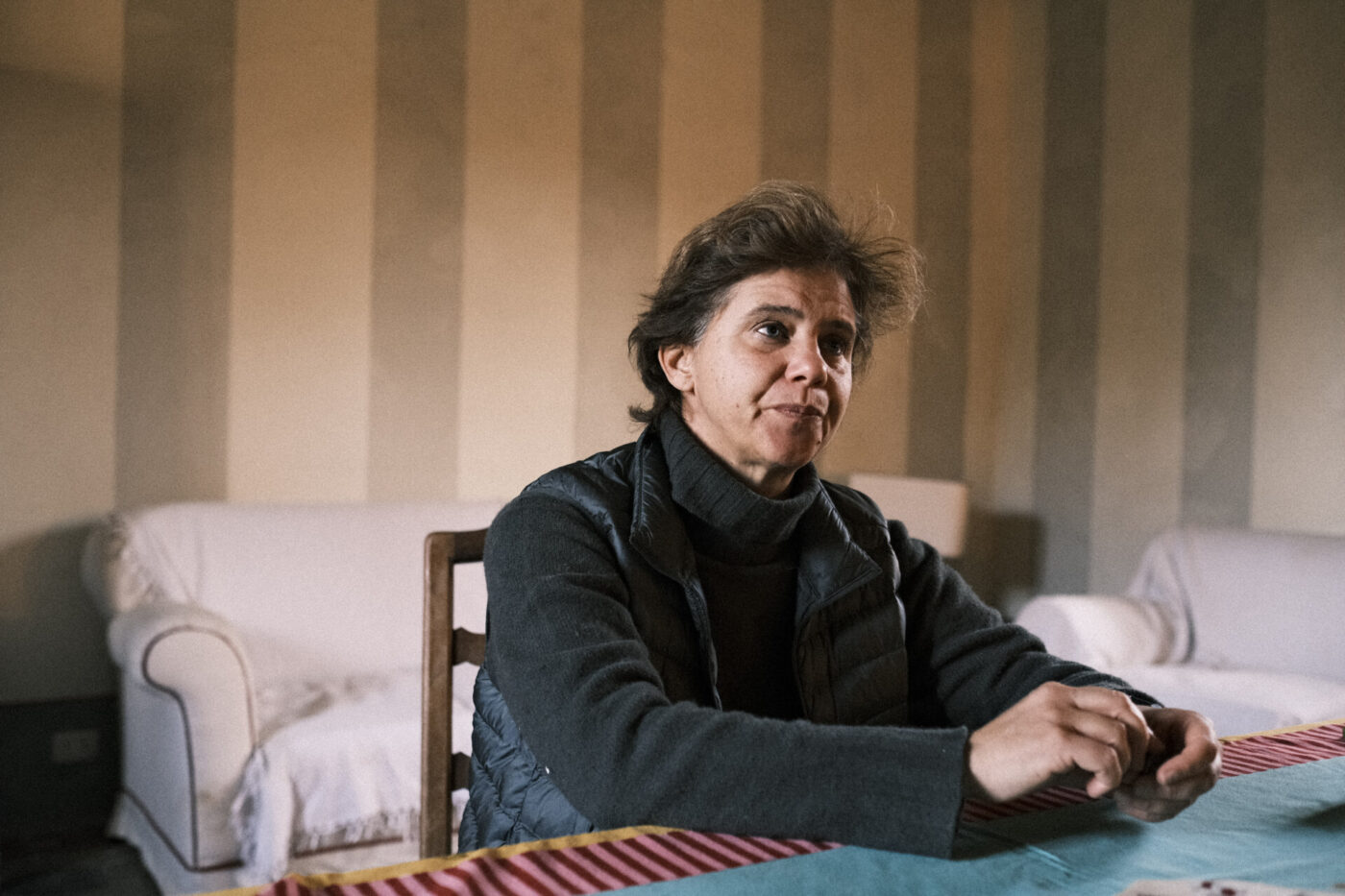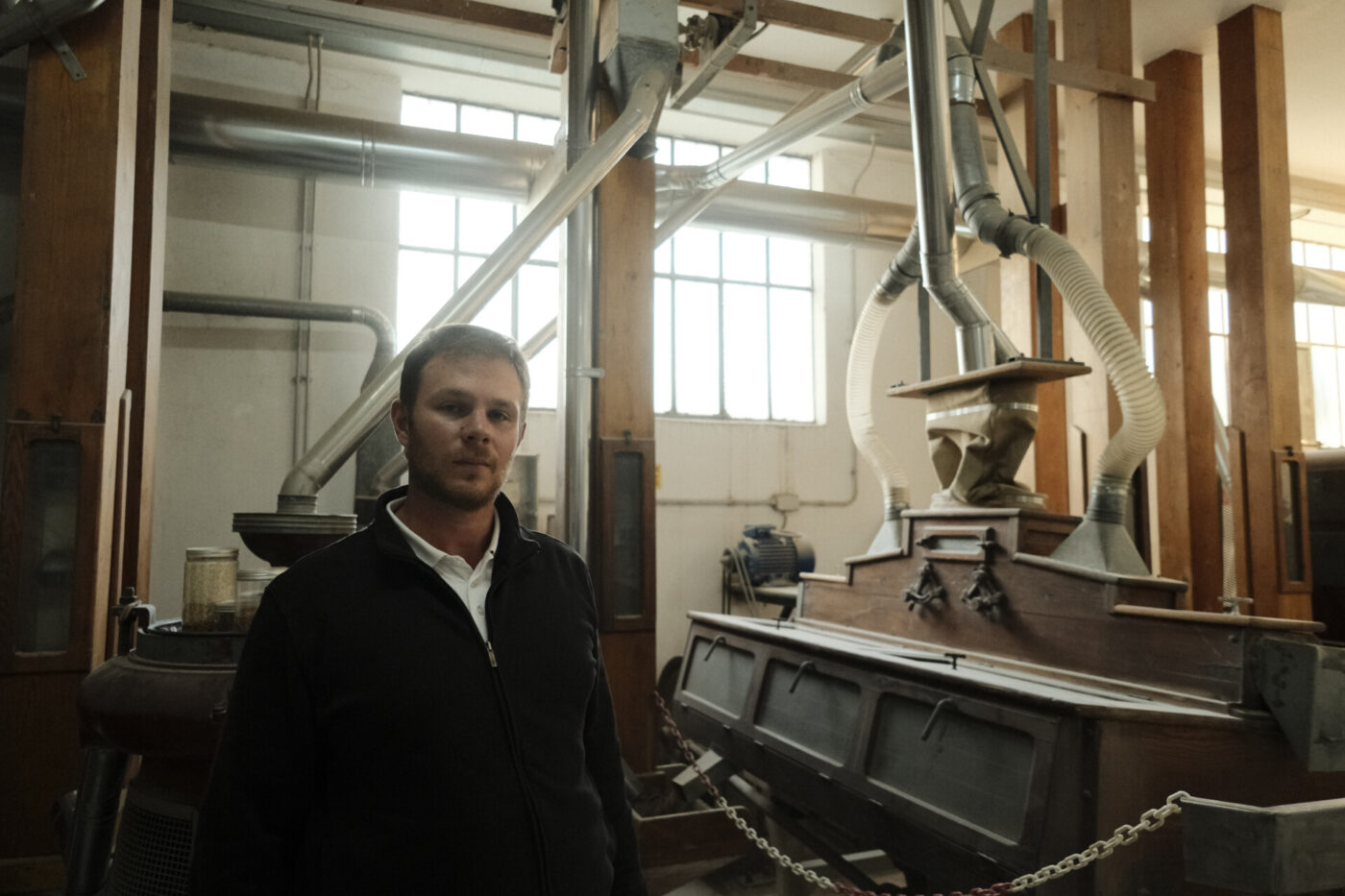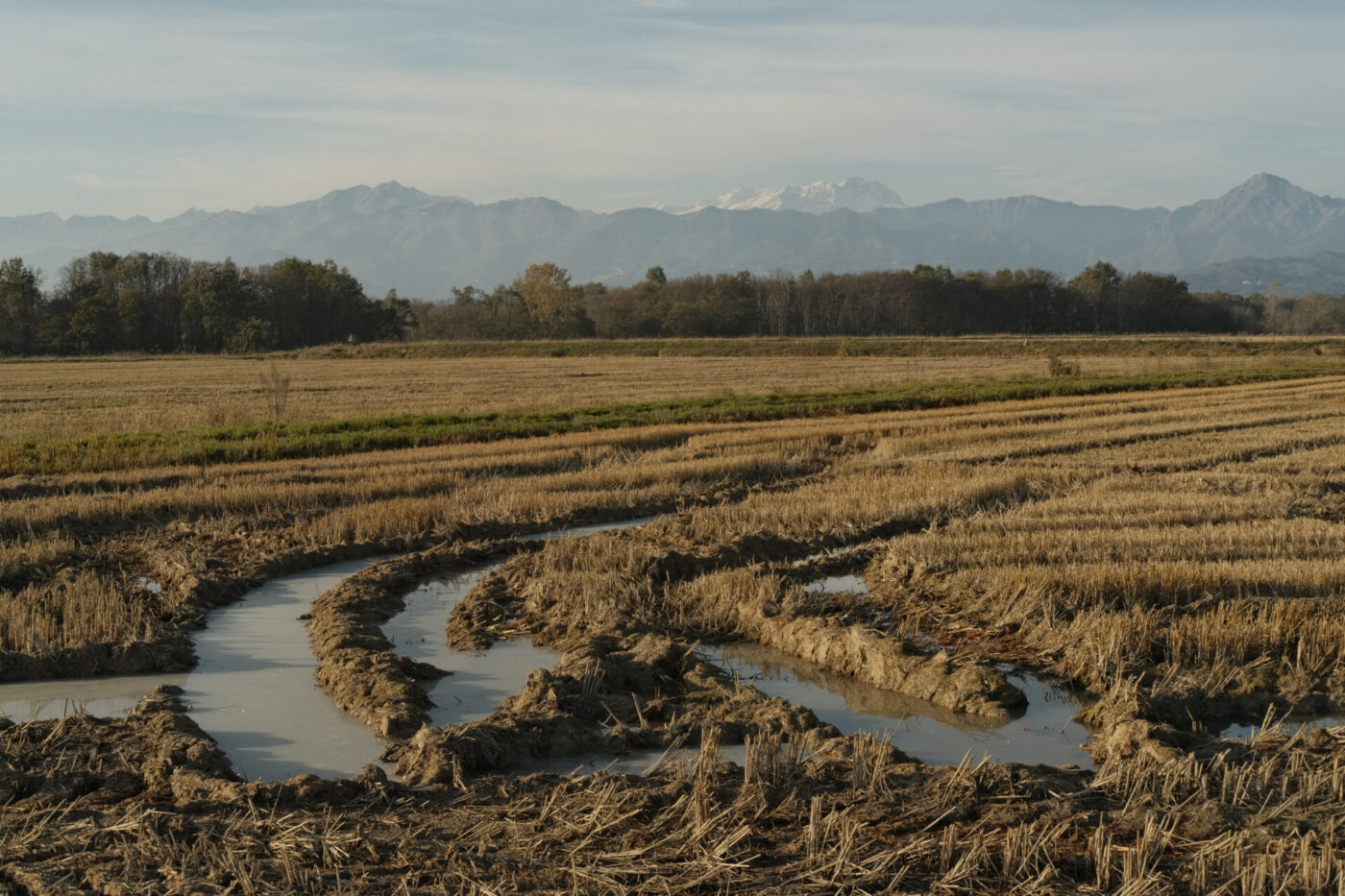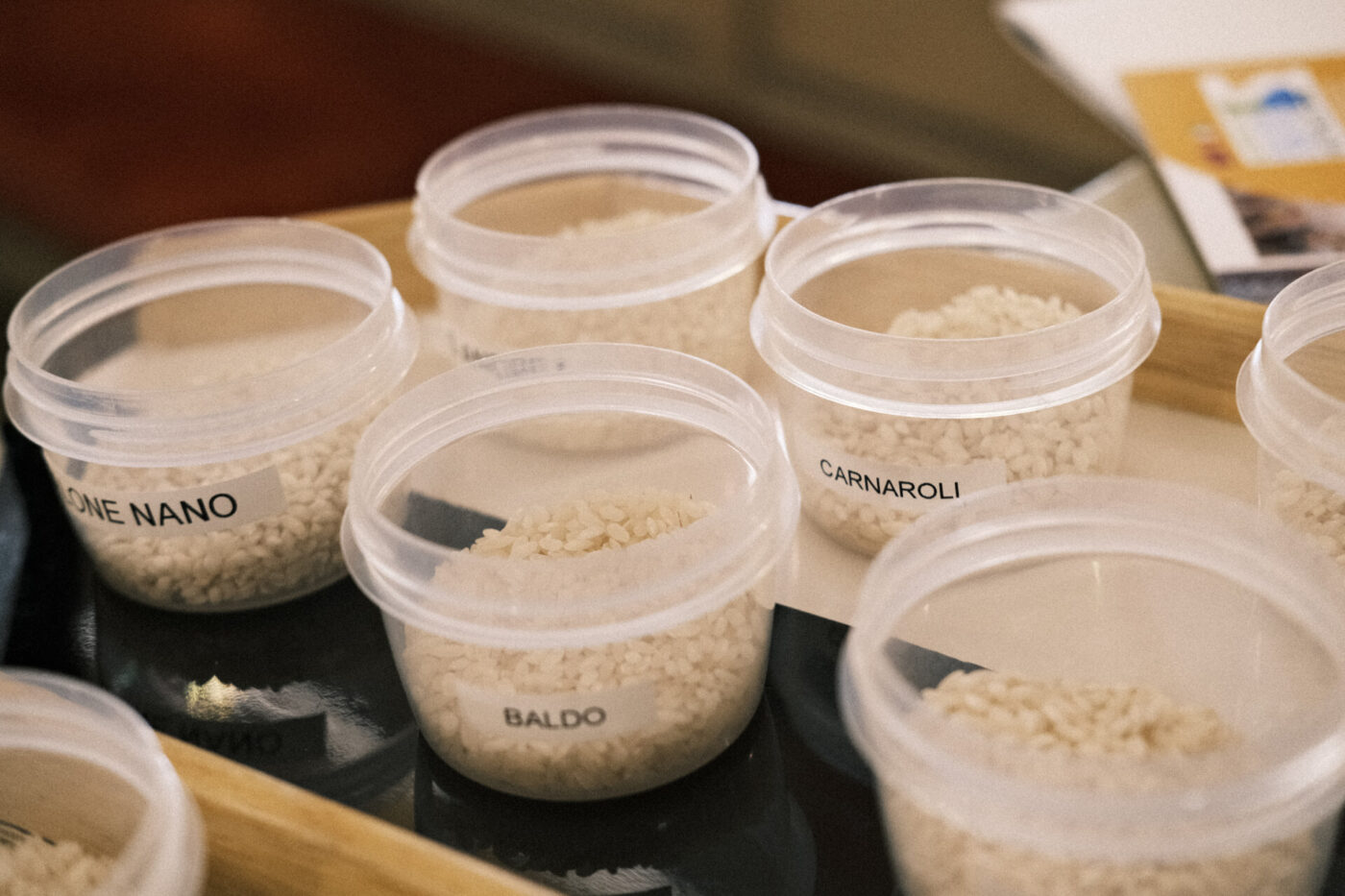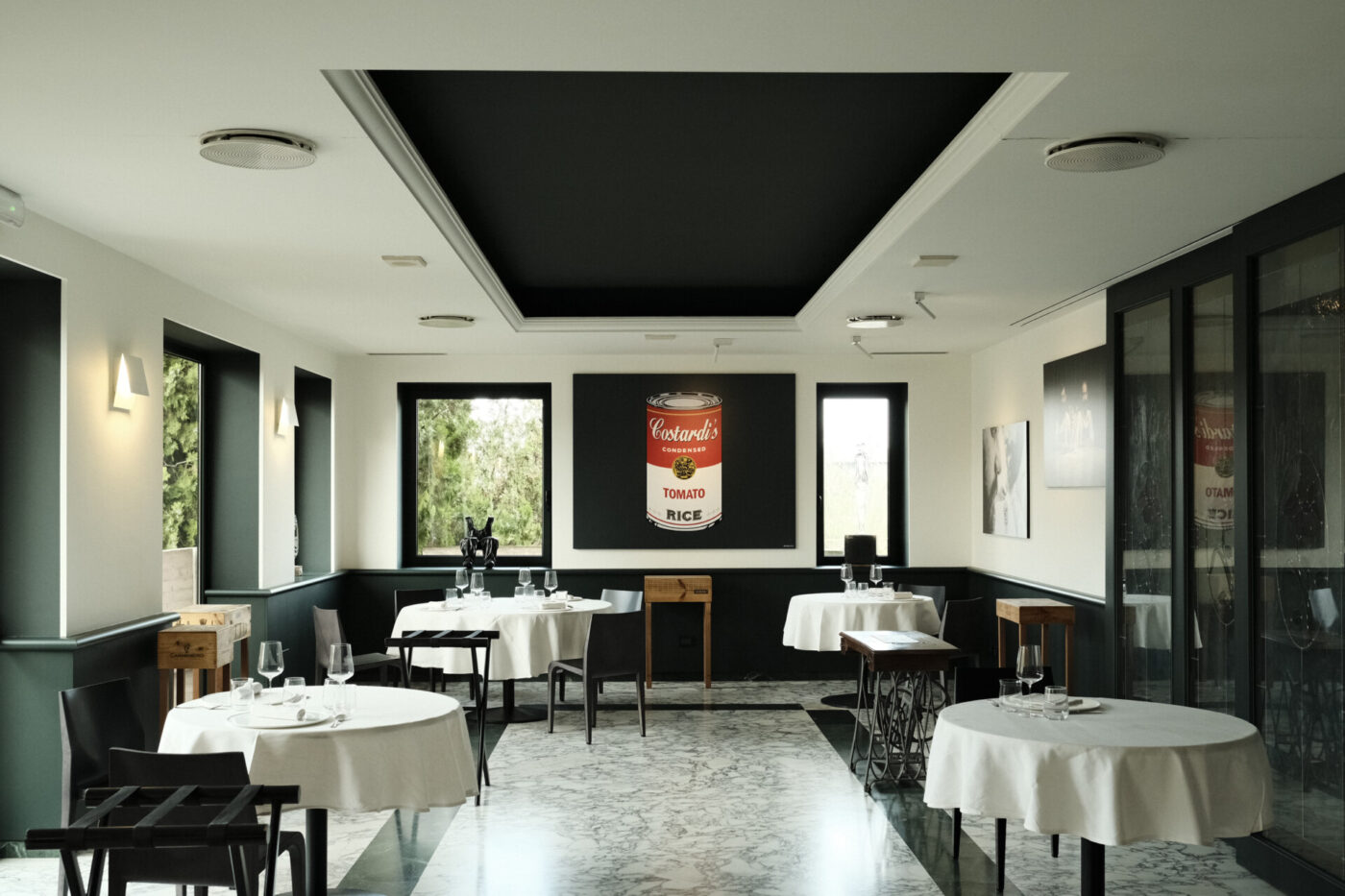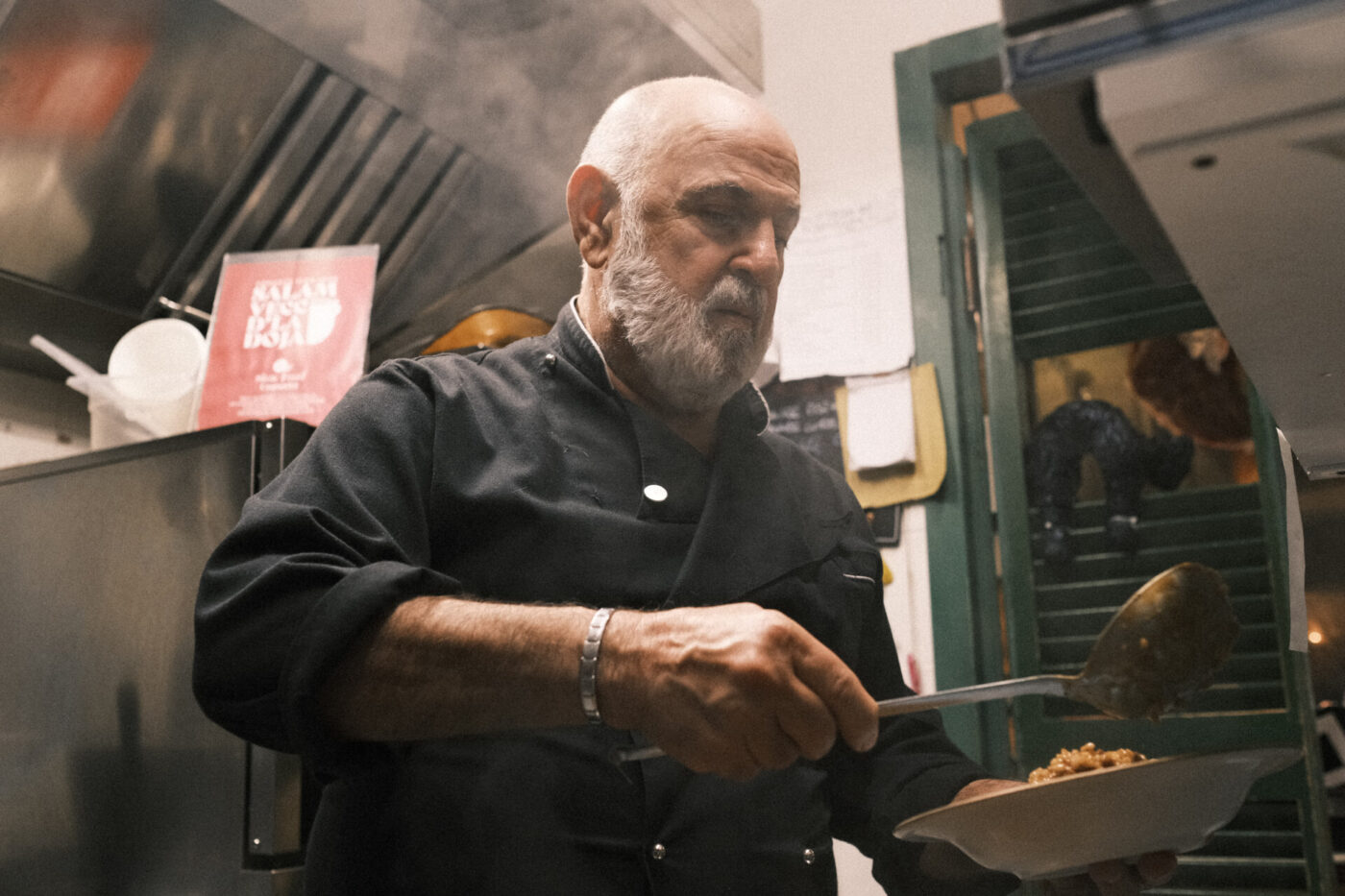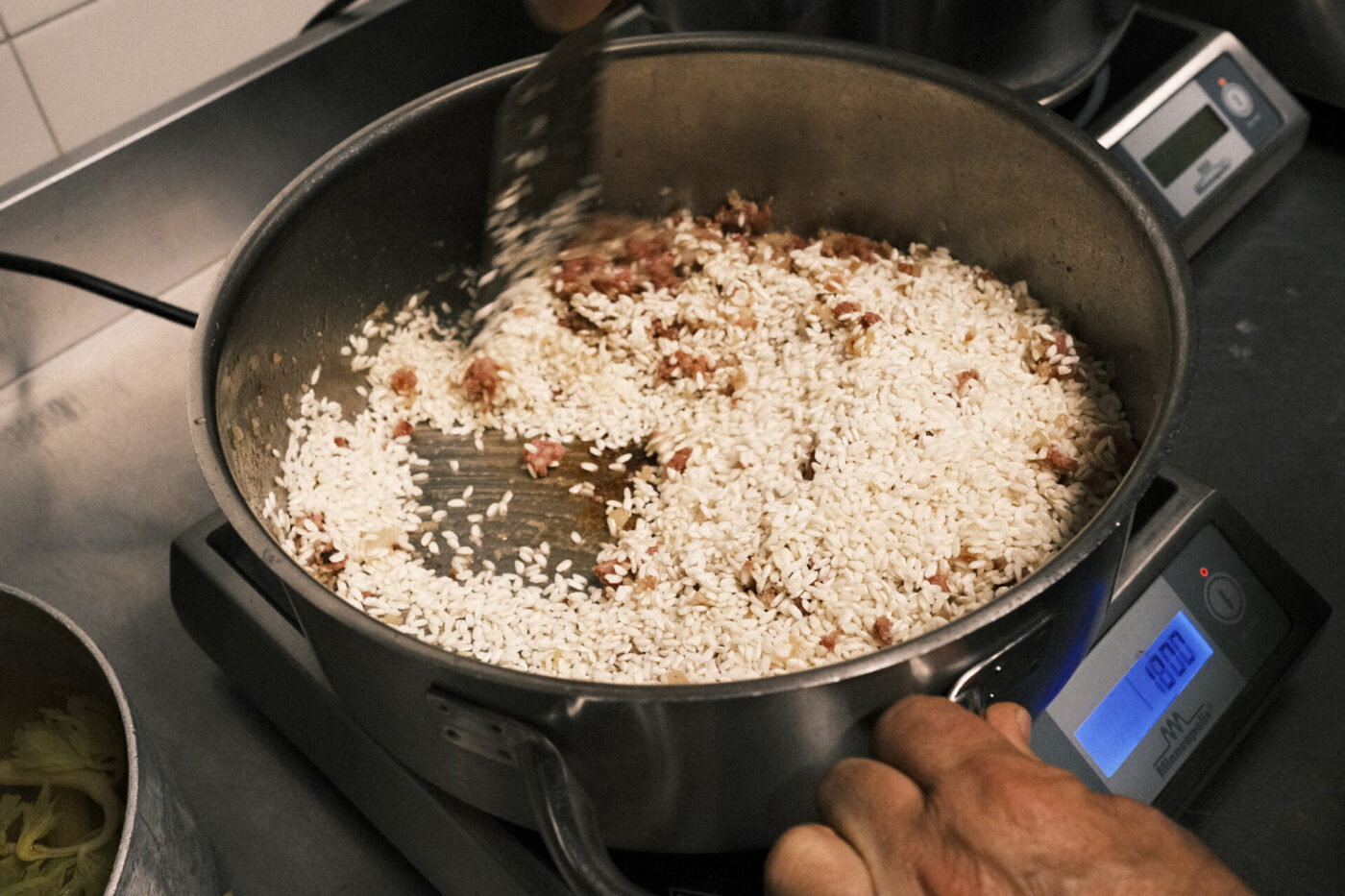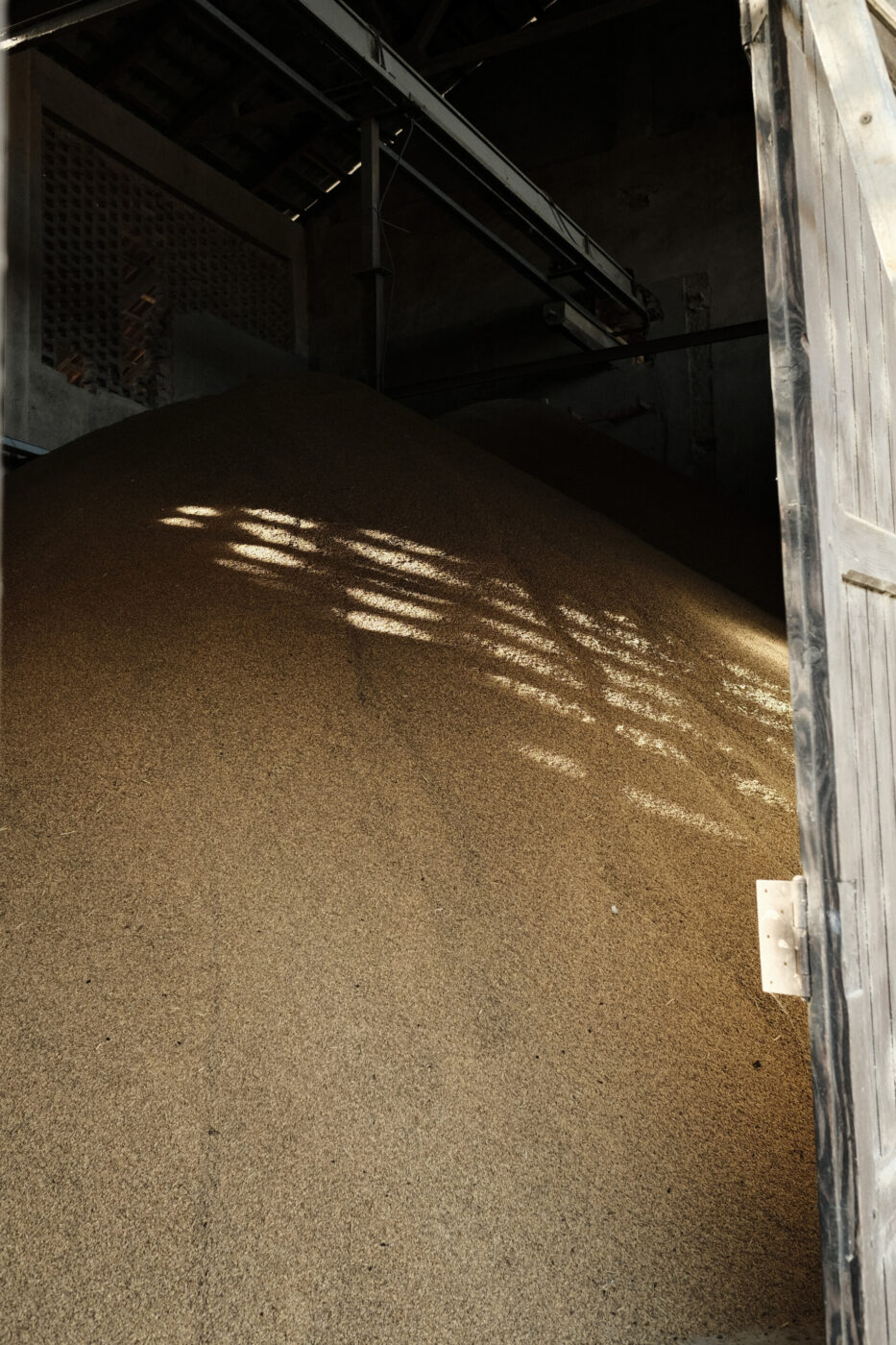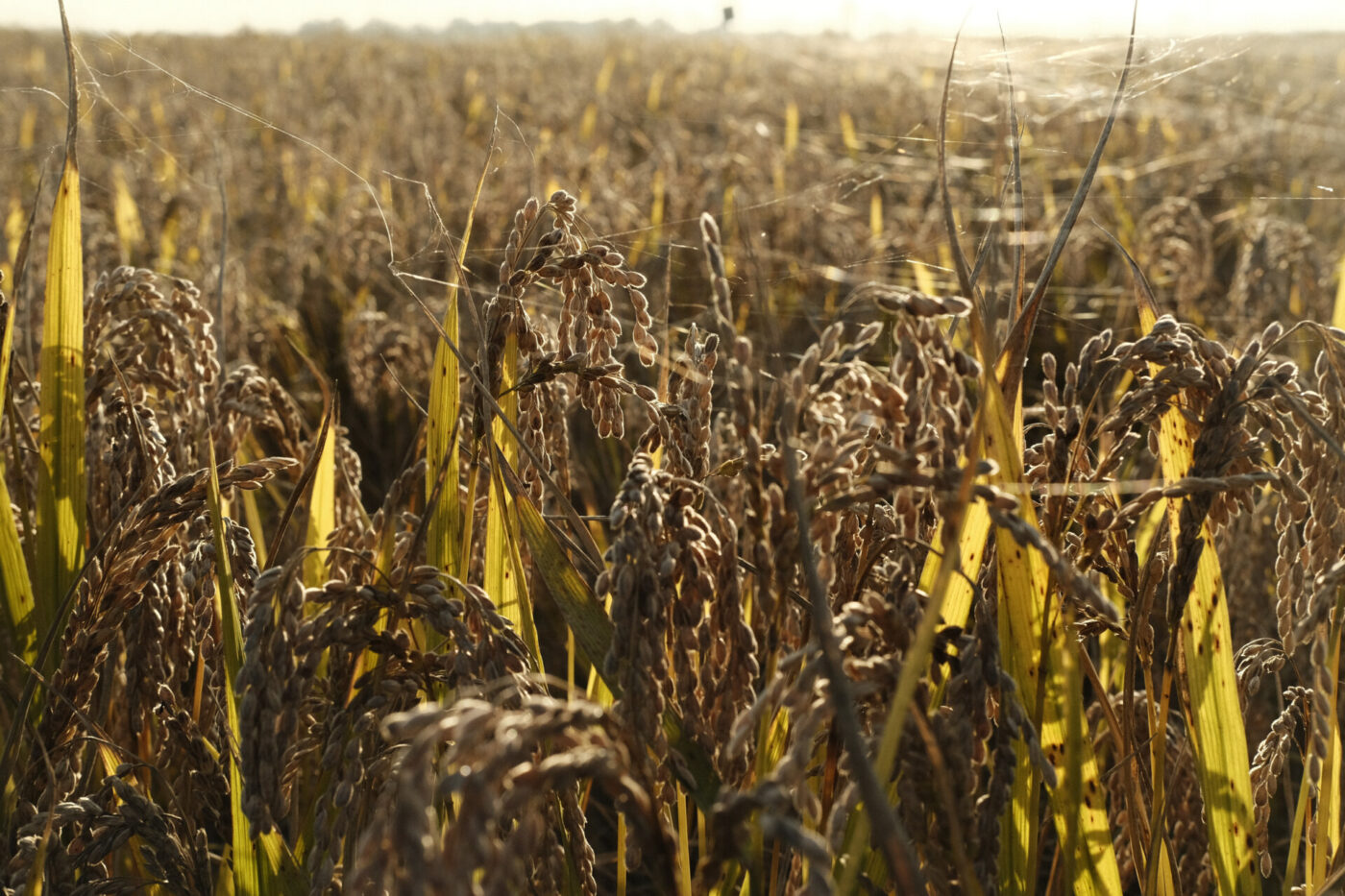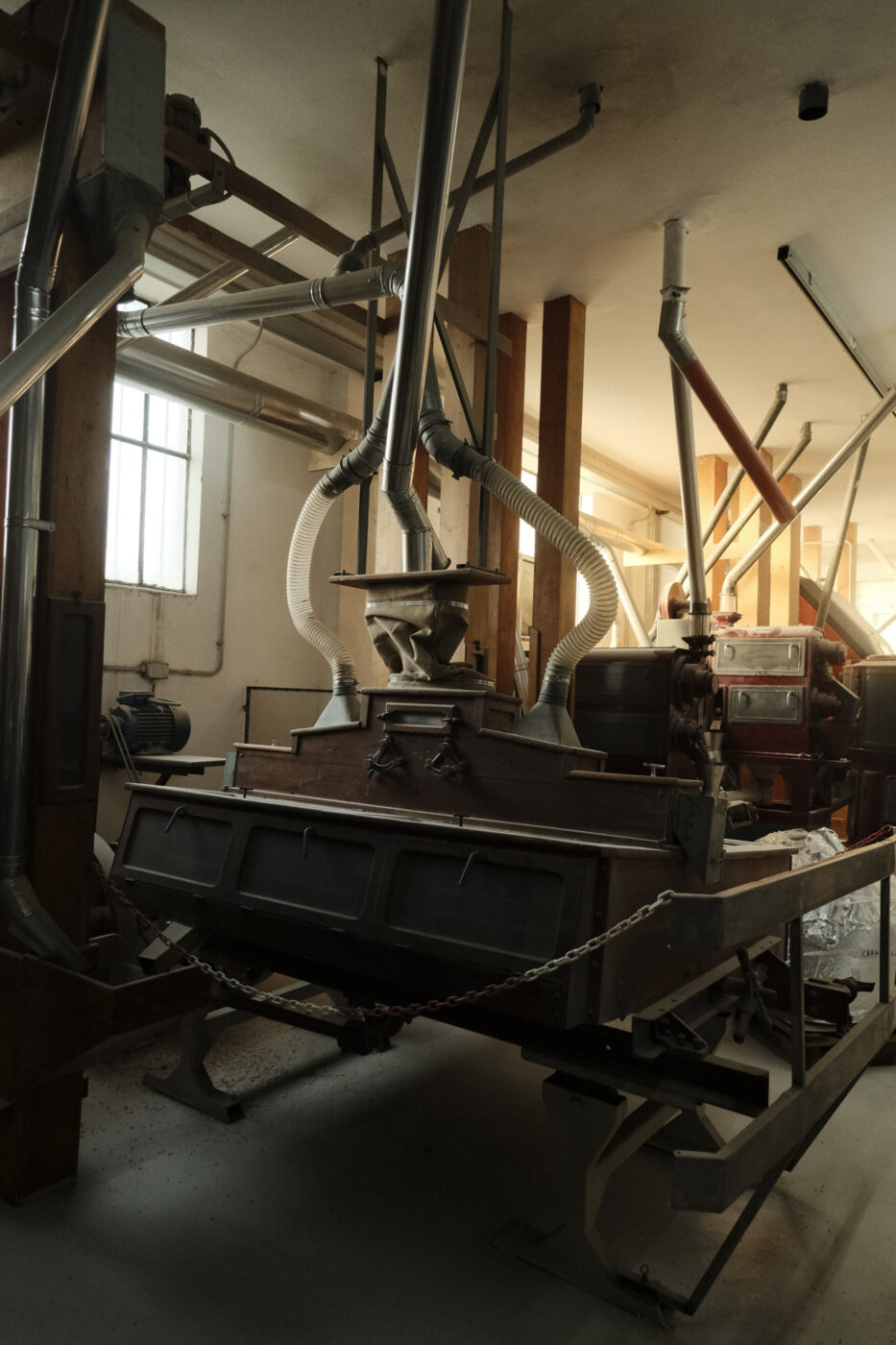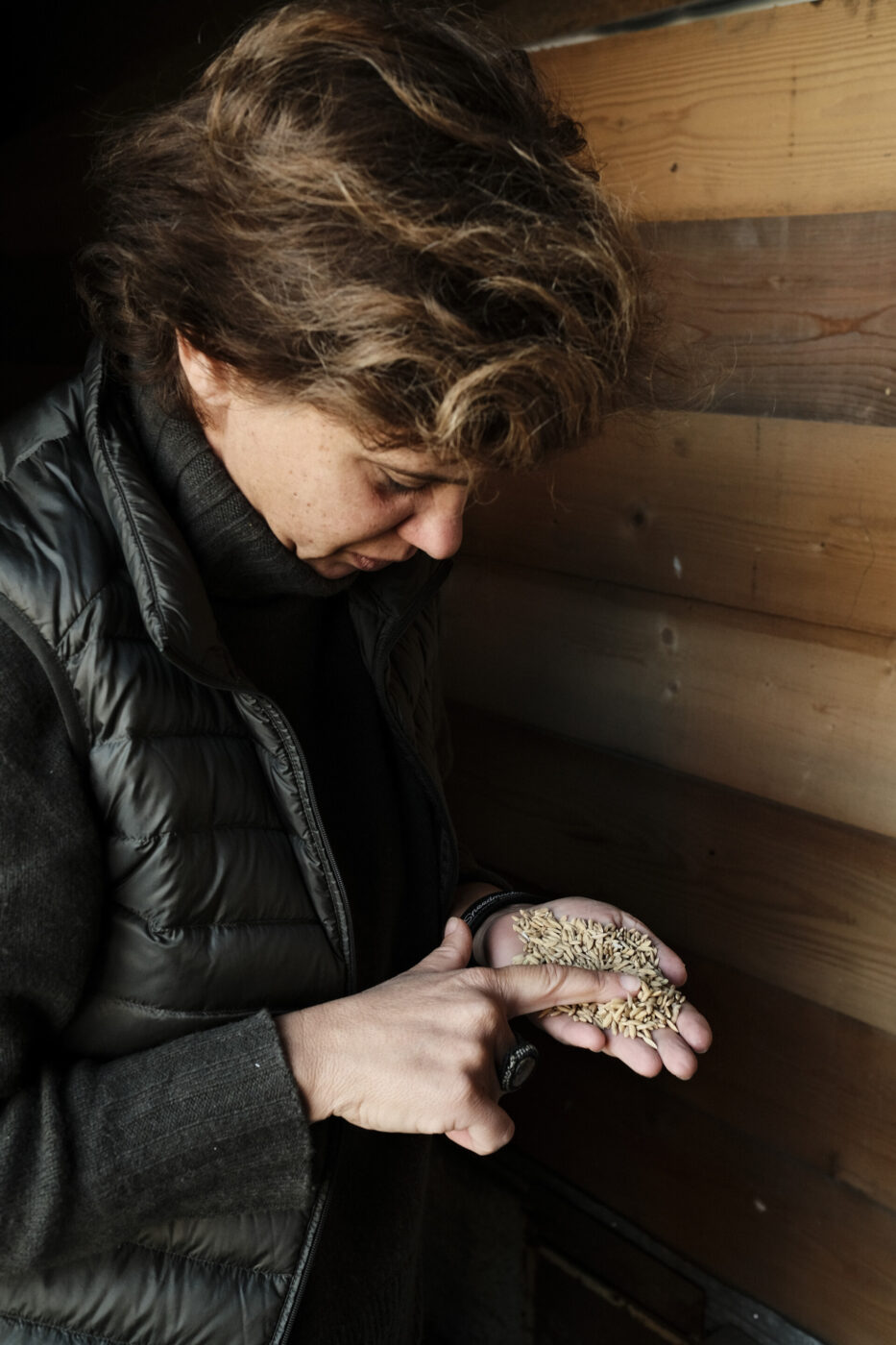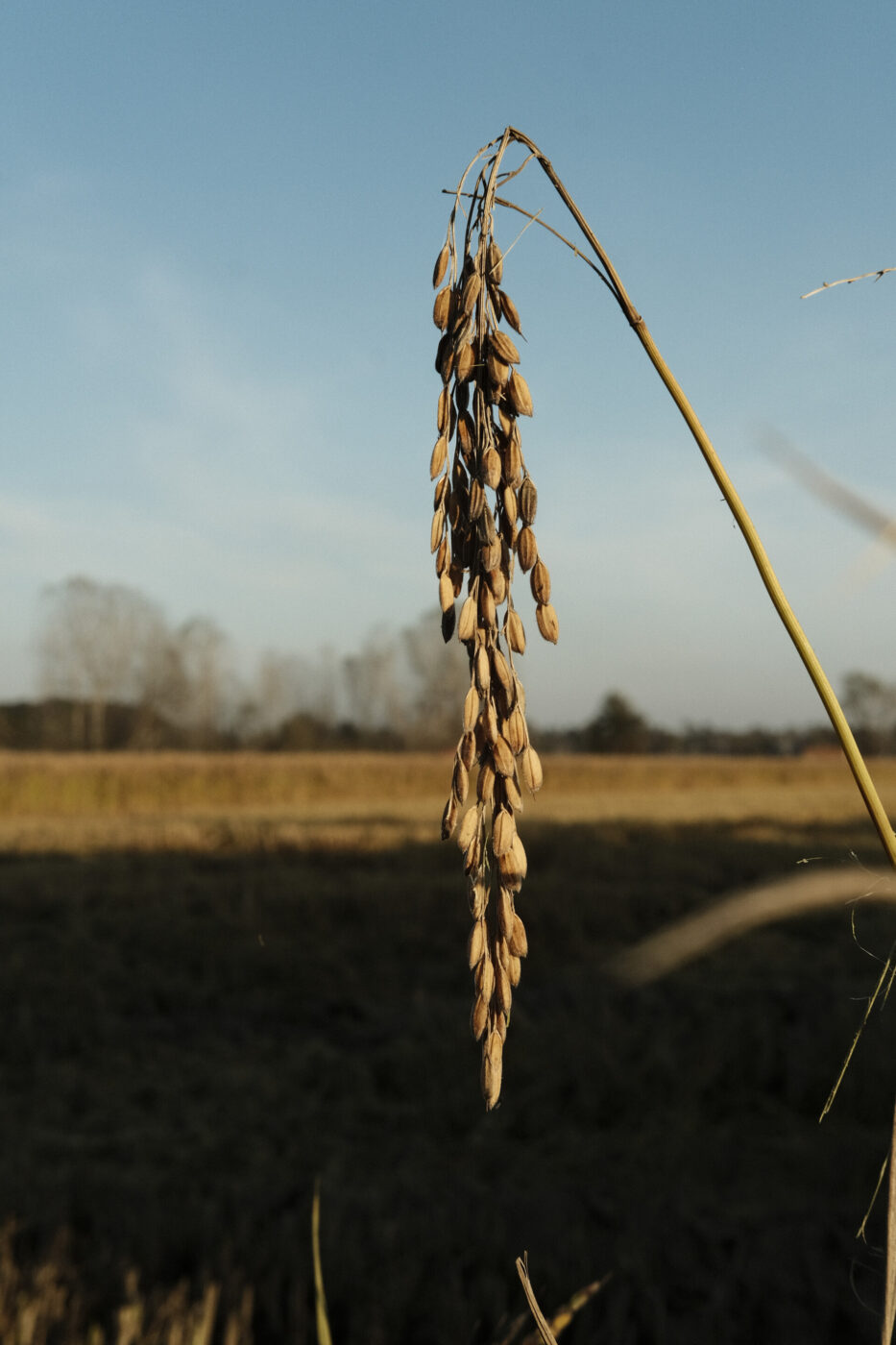Picture fog as far as the eye can see. Fog so thick you can’t see beyond your nose, and when the fog finally gives some respite and subsides, an immense plain stretching all the way into the distance, expanses of fields repeating themselves identically without interruption, a few farmsteads here and there, barely any trees or hills. The snow of the Monte Rosa, to the north, is the only reference point on the odd day of sun. This is how the province of Vercelli, eastern Piedmont, appears on your average day of November.

The rice fields in Vercelli
Though rice may not be the carb most affiliated with our country, Italy is Europe’s leading producer of the grain at 50% of the EU total, with 1.3 million tons produced per year–53% of which is exported to other European countries. Most of this can be attributed to the Po Valley, 46,000 square kilometers of fertile plain across northern Italy, from which 35% of Italy’s agricultural output originates. The history of rice production here dates back to at least the 15th century and central to it is the European capital of rice, Vercelli, exactly one hour away from either Milan or Turin. It’s here that many varieties commonly used for risotto grow, such as Arborio and Sant’Andrea; Vercelli is also the biggest producer of Carnaroli, which was crossbred not far, in Lombardy, in the immediate postwar period.
Slotted as it is between the Alps to its north, the river Dora Baltea to the west, the Sesia to the east, and the river Po to its South, the small city and the surrounding countryside were the beneficiaries in the mid-19th century of Canale Cavour, a 85-kilometer-long artificial canal whose construction was spearheaded by the namesake count, who, years later, would become the first Prime Minister of the just-born Kingdom of Italy. (He very much made sure the canal wouldn’t cut across his large estate.) Today, the waterway is still at the heart of a complex system which–operated by the Associazione OvestSesia–floods the rice fields each May, the beginning of the planting season, transforming the landscape into what is usually referred to as mare a quadretti (sea of little squares).
Vercelli is also the home of a less romantic history, that of the mondine. These women, who came mostly from the nearby provinces of northern Italy, were employed as seasonal weeders, spending long days bent over in ankle-deep water pulling weeds by hand to protect the crops, followed by nights in barracks. It was physically grueling work, often carried out under the hot sun or in damp, cold conditions, and they were notoriously underpaid, overworked, and subject to all sorts of abuse. Despite the hardships, mondine became a symbol of resilience and solidarity during the early 20th century, when they began organizing strikes and protests to demand better wages, working hours, and living conditions–decisive in achieving the eight-hour workday in 1906. (The mondine are also remembered by the resistance anthem “Bella ciao”, sung in the rice fields and famously adopted by Italian partisans during World War II.)
The mechanization that came in the 1950s and 1960s meant that the paesani that used to populate the cascine under the rigid, paternalistic control of the landowner moved to nearby Turin, swelling the ranks of factory workers sustaining the country’s booming industrialization. More than half a century later, even if employing a fraction of the people it used to, rice production is still the best lens through which to read Vercelli and the surrounding area–the driver behind its unique landscape, economy, and gastronomy. Titillated partly by descriptions of panissa, a “quasi-risotto” made of beans, pork, and a splash of Barbera which, until recently, was a staple in these parts, we decided to visit Vercelli in early November, just in time for the end of the rice harvest.
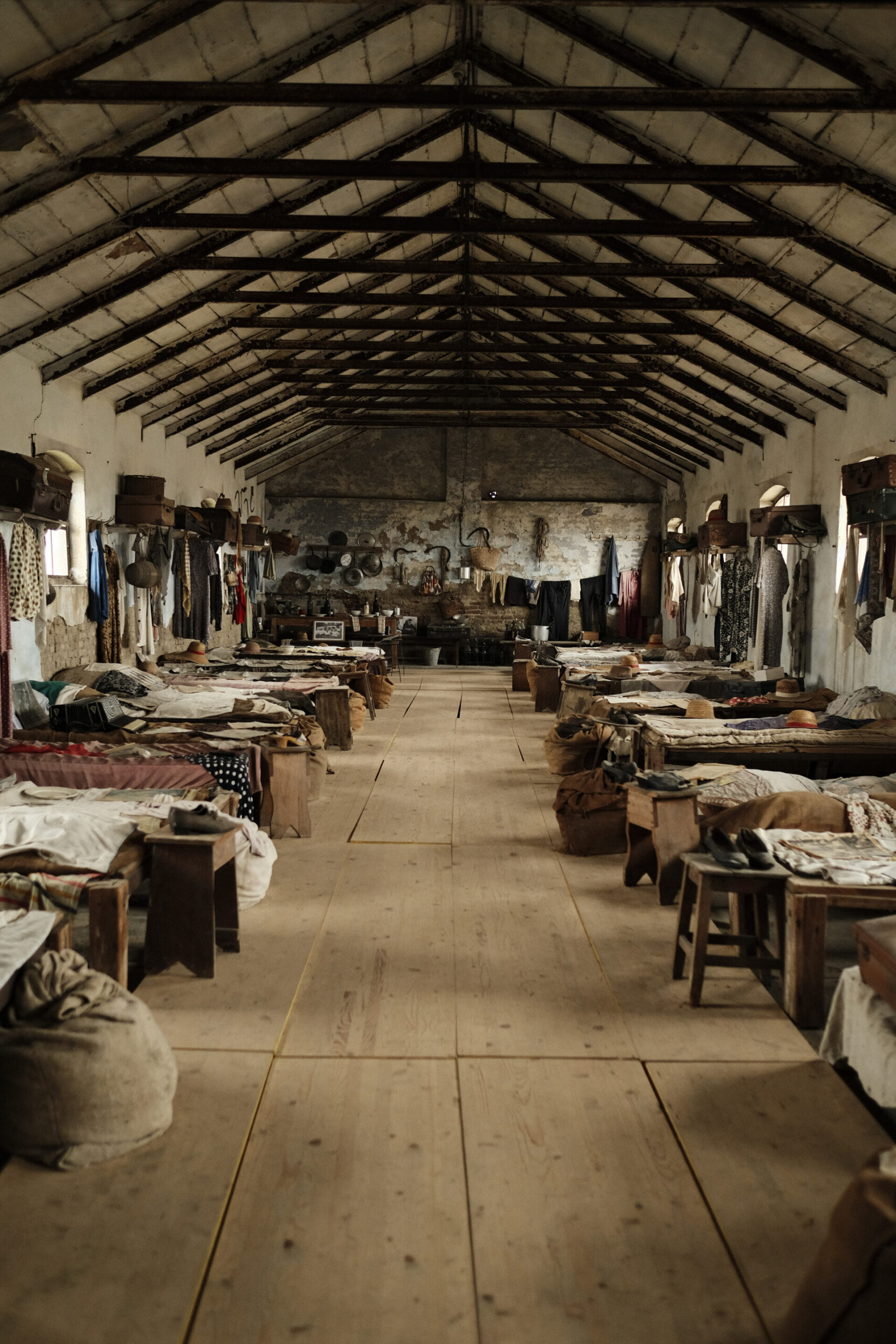
The mondine's dormitories
Vercelli’s Biggest Success Story: Acquerello
Set against the backdrop of foggy flatlands all around, the large estate of La Colombara appears in the early morning almost like a mirage.
Typical of this area of the Vercellese, long-known for the fertility of its soil and for that reason always subject to the control of landowners who divvied it up in large feudi (“Le Grange” is a borrowing from the French word for “granary”), La Colombara stands as a perfectly preserved, if slightly spectral, remnant. A casa padronale is flanked on each side by empty peasants’ quarters, with a large aia in the middle and detached mondine’s dormitories not too far away. Since 1991–the year owner Piero Rondolino stopped giving his risone (unpolished rice) to processing industrialists and instead produced a high-added-value final product and sold it directly to consumers–La Colombara has been home to the one of the great success stories of Italy’s agri-food sector. Today, Acquerello employs around 26 people, but Piero’s high-quality, aged Carnaroli is exported to 68 countries and used by Michelin-star chefs the world over. Even the home cooks worth their salt have a can, sporting a picture of the tenuta with the Alps in the distance, in their pantries.
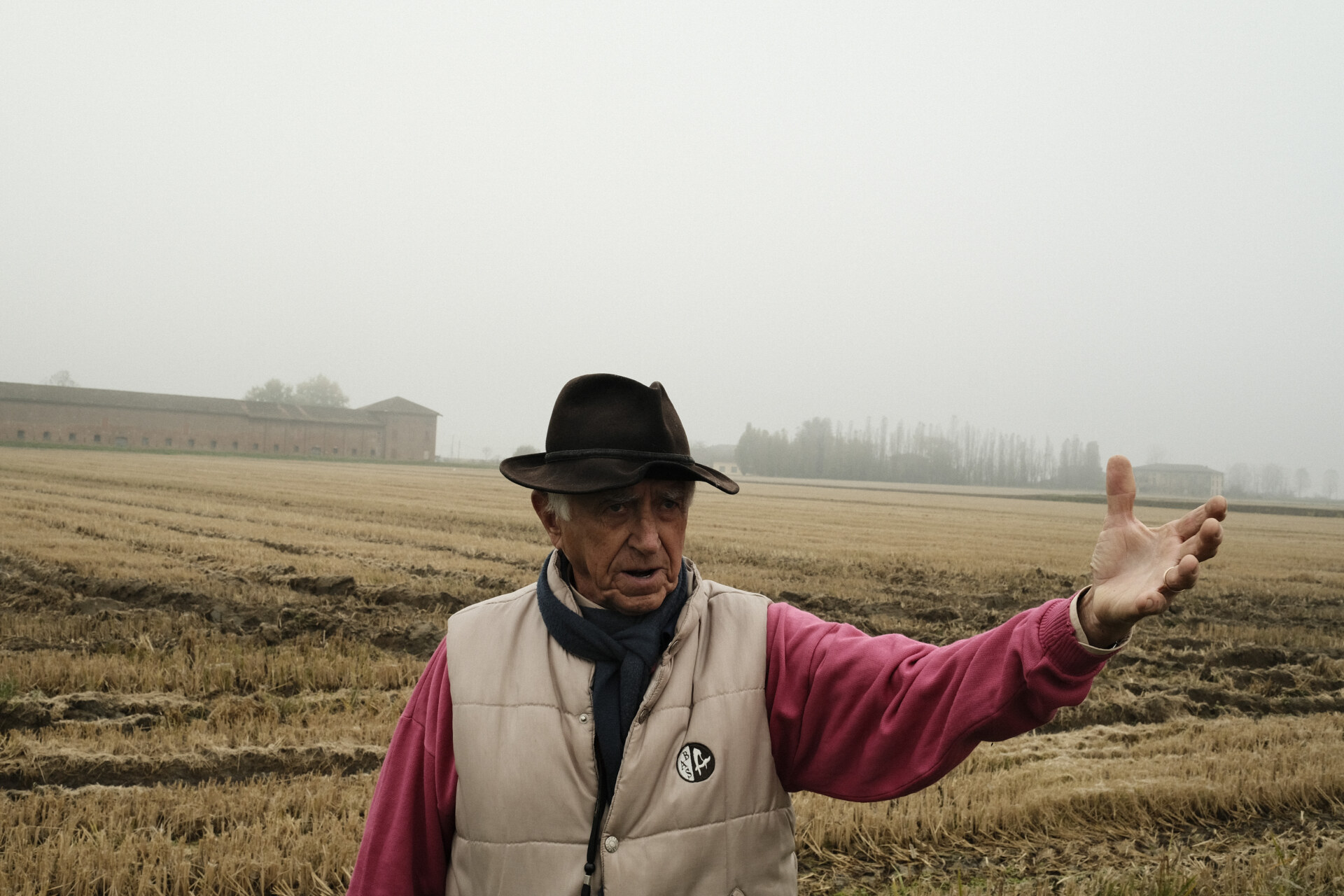
Mario showing the risaia for Acquerello
When we arrive, Piero (78) is just about to leave to go to visit the borsa merci (commodity exchange) in Vercelli. It’s one of the prized rituals that punctuates his life as a small agrarian entrepreneur–this and going to the local bar in Livorno Ferraris. “Nothing like showing up to the bar on a Sunday at 7:30 in the morning to have a coffee and hear what other producers are saying. It’s the best way to know how the season is going.”
A quick greeting over morning coffee soon turns into an hour-long conversation, during which Piero launches into free-wheeling descriptions of the Acquerello story, the merits of his unique business model, as well as the difficulties of the last harvest. “Being right on the 45th parallel”–a sort of Pillars of Hercules’ border beyond which it is no longer possible to harvest a grain of tropical origin like rice–“makes cultivation particularly susceptible to meteorological changes. This year it rained a lot, which is why we finished harvesting only a few days ago.”
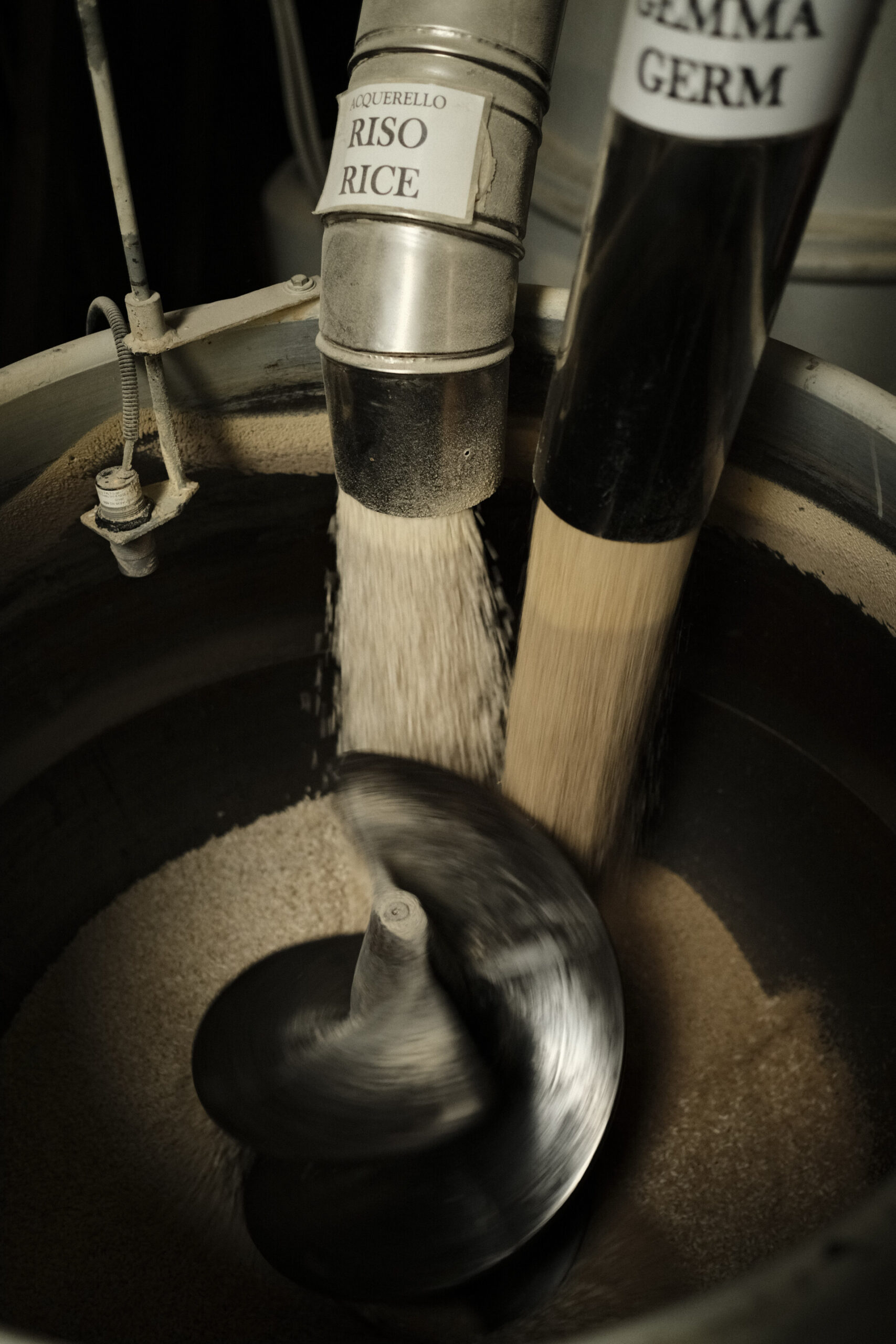
Acquerello differs from your regular Carnaroli in two fundamental aspects. First, the aging process, which, lasting at least over a year, ensures that the grains stay firm while cooking (nothing worse than mushy risotto!). Second, a special procedure–subject to copyright–spins the grain at a certain speed and temperature to reincorporate the nutritious germ, that is usually lost during the “whitening” process, back into the grain.
From our very first interaction, Piero feels compelled to reiterate the “urban” origins of his family (something which clearly transpires in his affable, yet firm manners). His father was a born-and-bred Torinese bourgeois who bought the estate in 1935, and Piero, before returning to work on the family’s estate as an acquaiolo (the person in charge of the delicate task of monitoring water levels) graduated in architecture in 1971.
Still, when we mention that we’re looking to try the historic farmers’ plate panissa vercellese–the soup combining the contadini staples consumed in these parts: rice, pork, and beans–he gets a sparkle in his eyes. He asks whether we would like to stay for lunch (we very much do) and in a matter of minutes he arranges a traditional paiolo full of panissa to be prepared at the osteria nearby. At the table, his digressions about the etymology and different versions of the dish mix with memories from Mario, a local in his 80s who grew up on the estate in the immediate postwar and now, in his retirement, acts as a guide to those who want to get a snapshot of the anything-but-idyllic life on the risaia.
From what they tell us, it becomes apparent that there is no set recipe for panissa, that every family has their own version; that said, some ingredients, such as salame d’la doja (a kind of local salami kept in rendered fat) and Saluggia beans, in addition to rice, are non-negotiables. Historically, the recipe would vary greatly on the economic conditions of who prepared it. The panissa made day-to-day by mondine was really a poor, dry minestra composed of the meager vittles provided in their seasonal contracts. The panissa made by the fattore (managers) saw the addition of puntel (ground, non-aged salame). At the other end of the spectrum, panissa prepared on Sundays for the landowners was a much richer and varied affair, a sort of risotto enriched by different kinds of meat and made more interesting by the tang of a good Barbera cutting through the fat.
After lunch, Piero’s son Umberto (50), now head of research and development after a career as an industrial designer in Turin, shows us the big silos where the rice is dried until it reaches 15% humidity and then aged–sometimes as long as seven or eight years. He also shows us the small plant where rice is processed on demand; a complex, laborious operation that in all lasts 24 hours and, in addition to winnowing (that is, separating the rice from the chaff), sees the rice go through 20 different machines–some brand-new, some “salvaged” by Piero–before it gets bottled in the iconic Acquerello can.
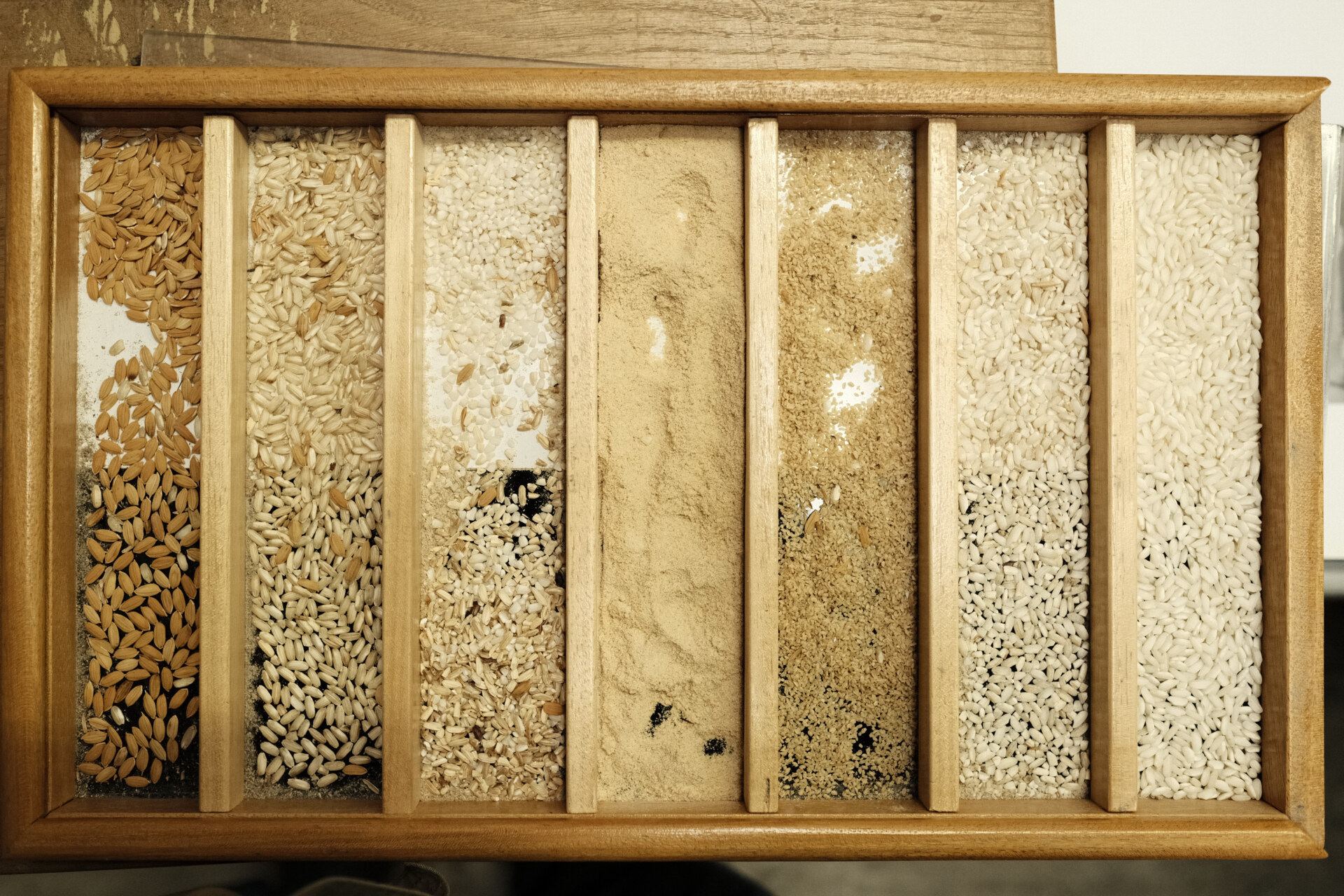
Baraggia and the Only DOP Rice in Italy
La Colombara stands out–not necessarily for its size, but for its pioneering spirit. They were among the first to break away from treating rice as a mere commodity, choosing instead to market their own high-quality product in a market where profitability was dwindling. Inspired by their success, many other producers have since found creative ways to differentiate their rice. To explore further, we head north to Baraggia–the home of Italy’s only DOP-certified rice.
The landscape when we arrive at dusk–vapors rising from the muddy rice paddies, recently harvested as a result of the temperature change–is nothing short of Shakespearean. Matteo Musso (39), the former lawyer who, together with other 19 producers and 6 risiere (processing facilities) make up the Consorzio Riso di Baraggia, explains that Baraggia is a wetland, swampy and difficult to cultivate. (The word “Baraggia” itself likely has a Celtic origin and suggests the idea of a barren heath full of brambles.) What was always a disadvantage became a boon when the reclamation consortium, spearheaded by agronomist Arrigo Serpieri (1877-1960), turned the inhospitable, forsaken back country into newly available prime land for upcoming smallholders willing to cultivate rice.
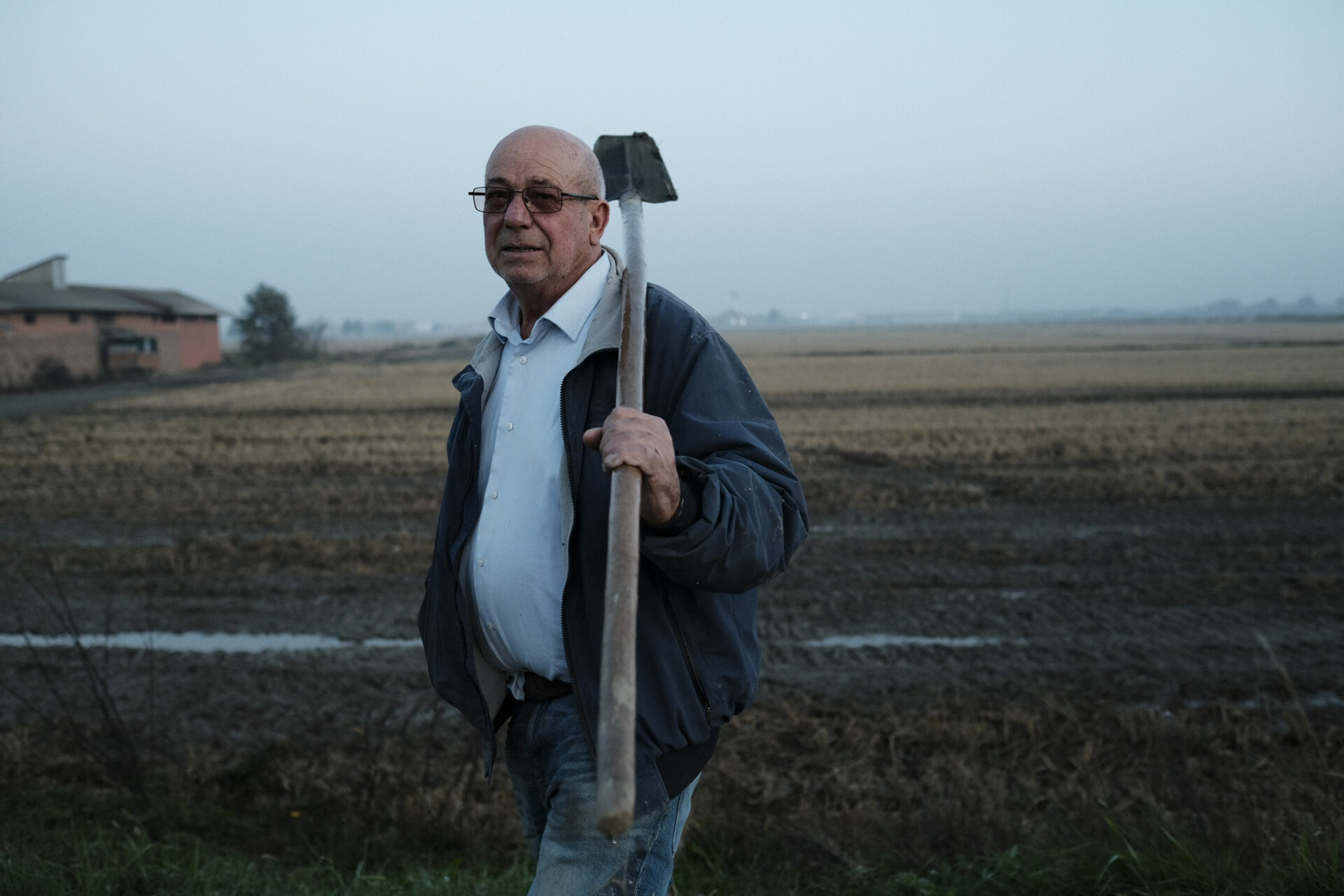
Piero hacking at the field with his badile (shovel)
While we walk toward the muddy fields at the back of the farm–a cascina his family bought off the noble family that employed them and that once housed over 800 people–he points to a barely visible plateau in the direction of Biella. “That’s the Serra di Ivrea, where the glaciers stopped. The subsequent melting created the swampland known as Baraggia.” Not only is the soil a clay one like in Le Grange, which means that water doesn’t drain, but also the colder climate and the water that “percolates” down from Valle d’Aosta through the nearby Dora Baltea produces a lower yield of smaller grains, but of much higher quality. While we watch his uncle Piero hacking at the field with his badile (shovel), so the water trapped after the reaping of the mietitrebbia (combine harvester) can flow back to the canal, the subject moves to panissa. Matteo confirms that the best variety of rice to use is Sant’Andrea–smaller than Carnaroli–but when we ask for trattorias where to try it, he’s at a loss. “It’s not like Piacenza around here.”
We drive over to Busonengo next, an old borgo that used to house over 200 people, but is now home to Igiea Adami’s farm Beni di Busonengo. The cascina, with an old tiled stufa and back garden where bees buzz around freely, has been in the family since Igiea’s ancestor, adventurer Paolo Solaroli (1796–1878) purchased it with money earned while working for the East India Company; he’s rumored to have inspired the pirate Sandokan.
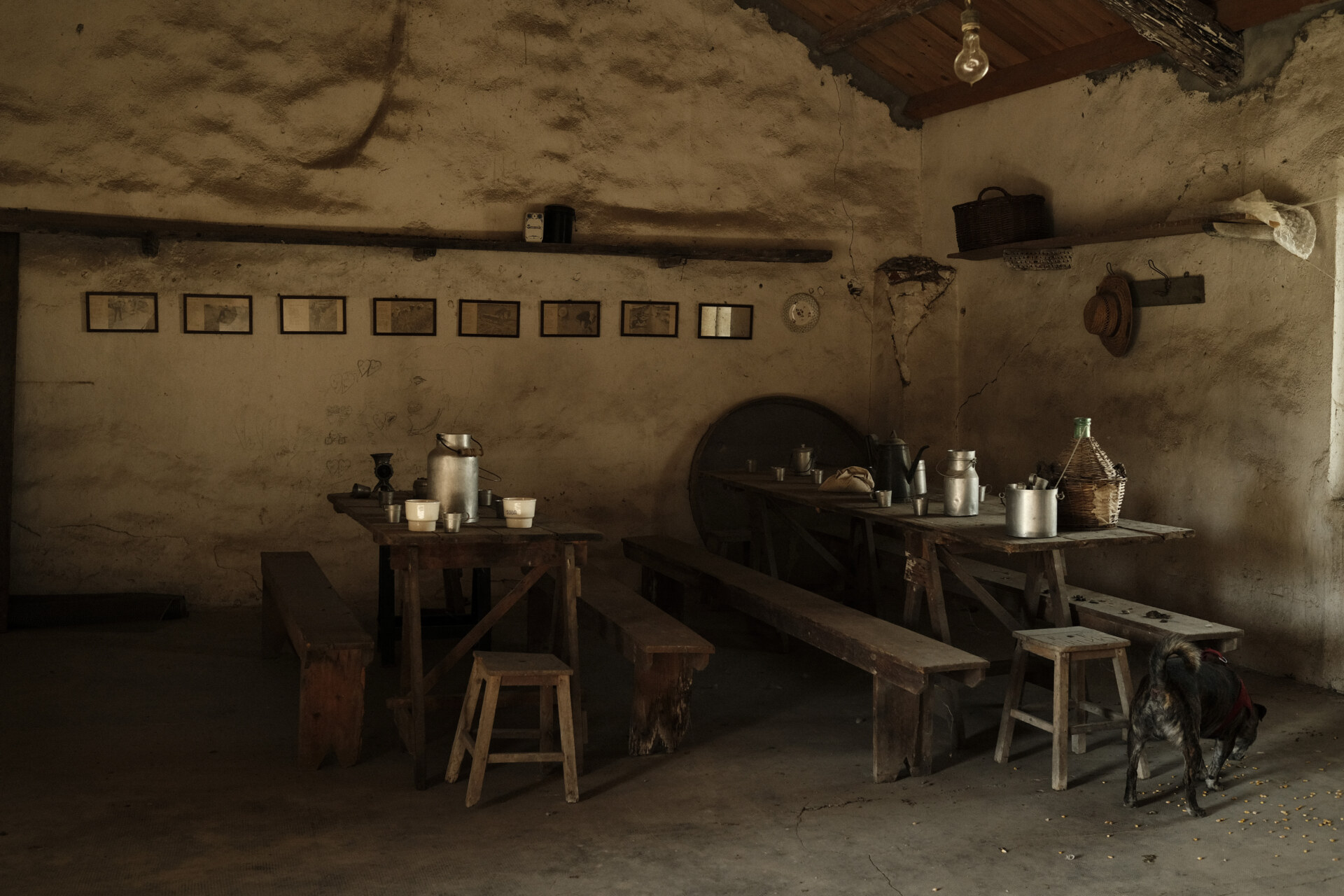
Igiea Adami’s farm, Beni di Busonengo
Igiea (47) is known in the area for her ambitious project terreamano. The initiative–which unfortunately is on hold at the moment–came to Igiea after making natural wine with her husband Guido Zampaglilone. She put aside a small patch of land to be worked the old way, sowing and weeding rice by hand instead of by a combine harvester, the goal being to conserve the biodiversity of the patch and create a product free of fertilizers and herbicides. “We had made a vivaio, like in the old days. When the seedlings were tall enough to crowd out other weeds, we would replant them in the paddy field,” she tells us. “It sounds like a miracle, but it worked.”
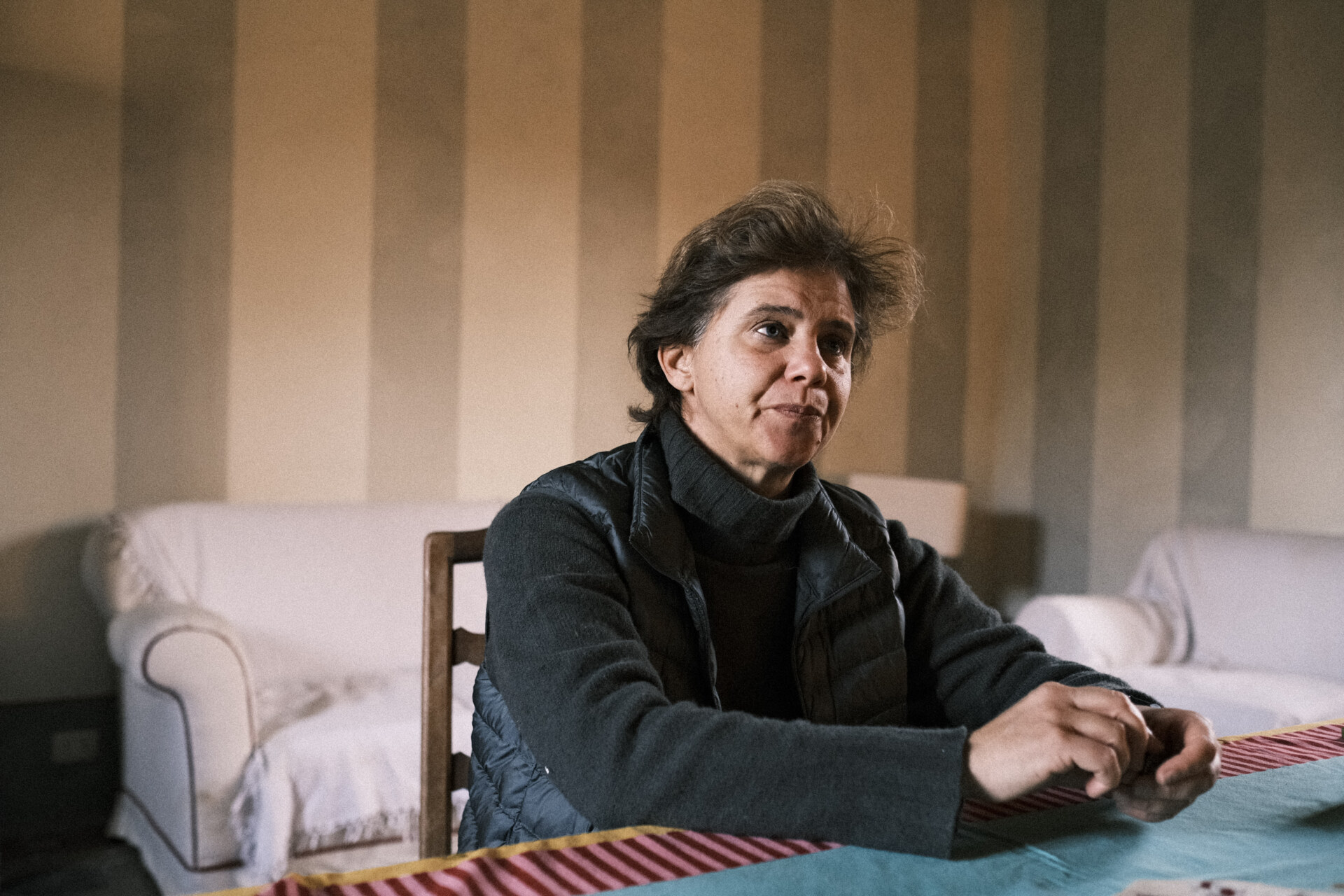
Igiea
During our stay, she shows us the hundred-year-old essiccatore, a drying warehouse where the humidity of the rice is brought down by hot fans, as well as what remains of the old peasants’ quarters and a chapel which, until not long ago, housed a thriving community.
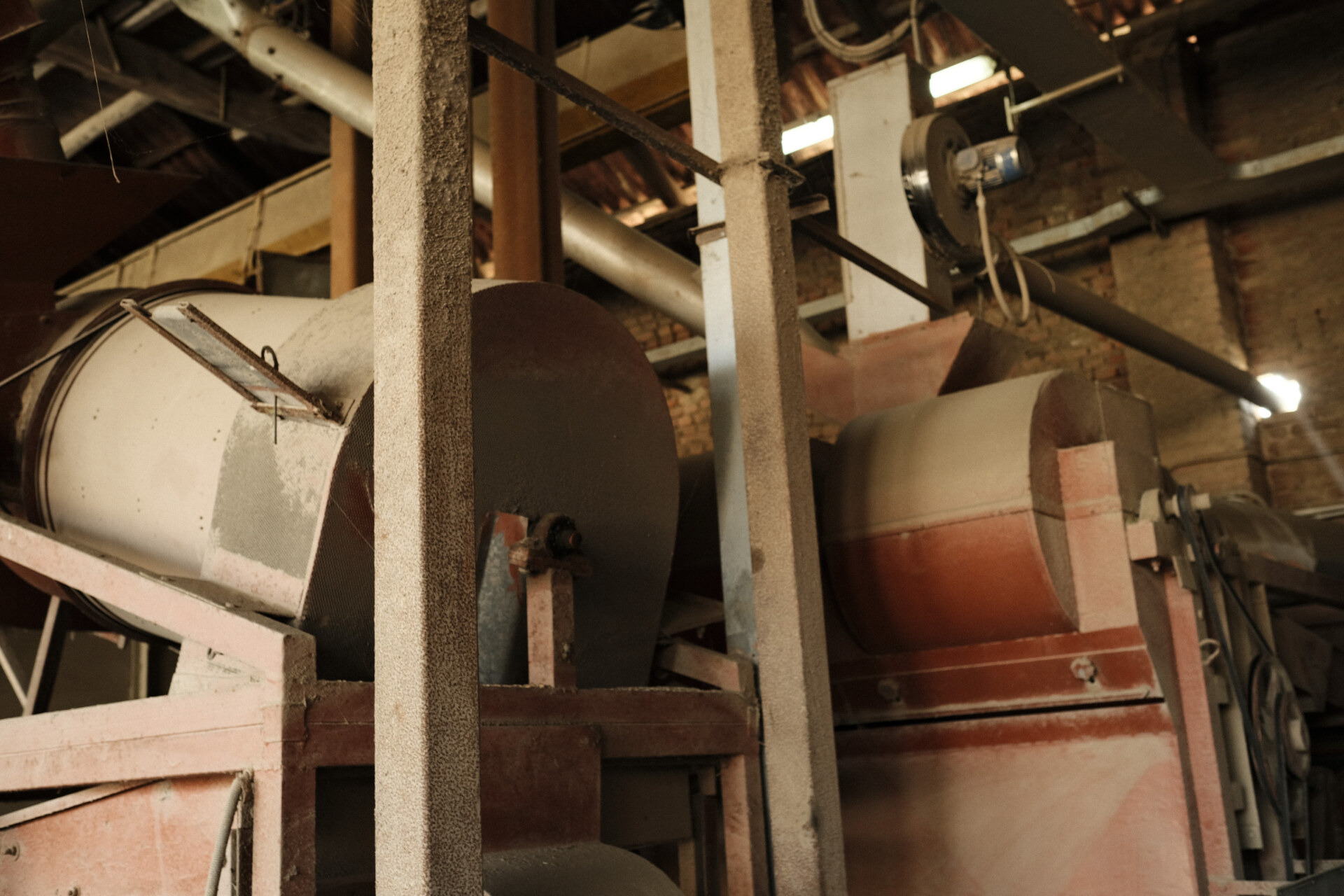
Igiea's hundred-year-old essiccatore (drying warehouse)
The same day, we visit Rovasenda and another producer, Matteo Tomasoni (35), who takes precious time out of the last couple days of harvest to show us around the rice fields and operating risiera. Matteo is also part of the DOP consortium; he produces Sant’Andrea, Carnaroli, and other varieties and, during the remainder of the year, plants his fields with loietto (a kind of grass). “It’s a way to restore the fields’ fertility and to not have to use as many chemicals,” he explains.
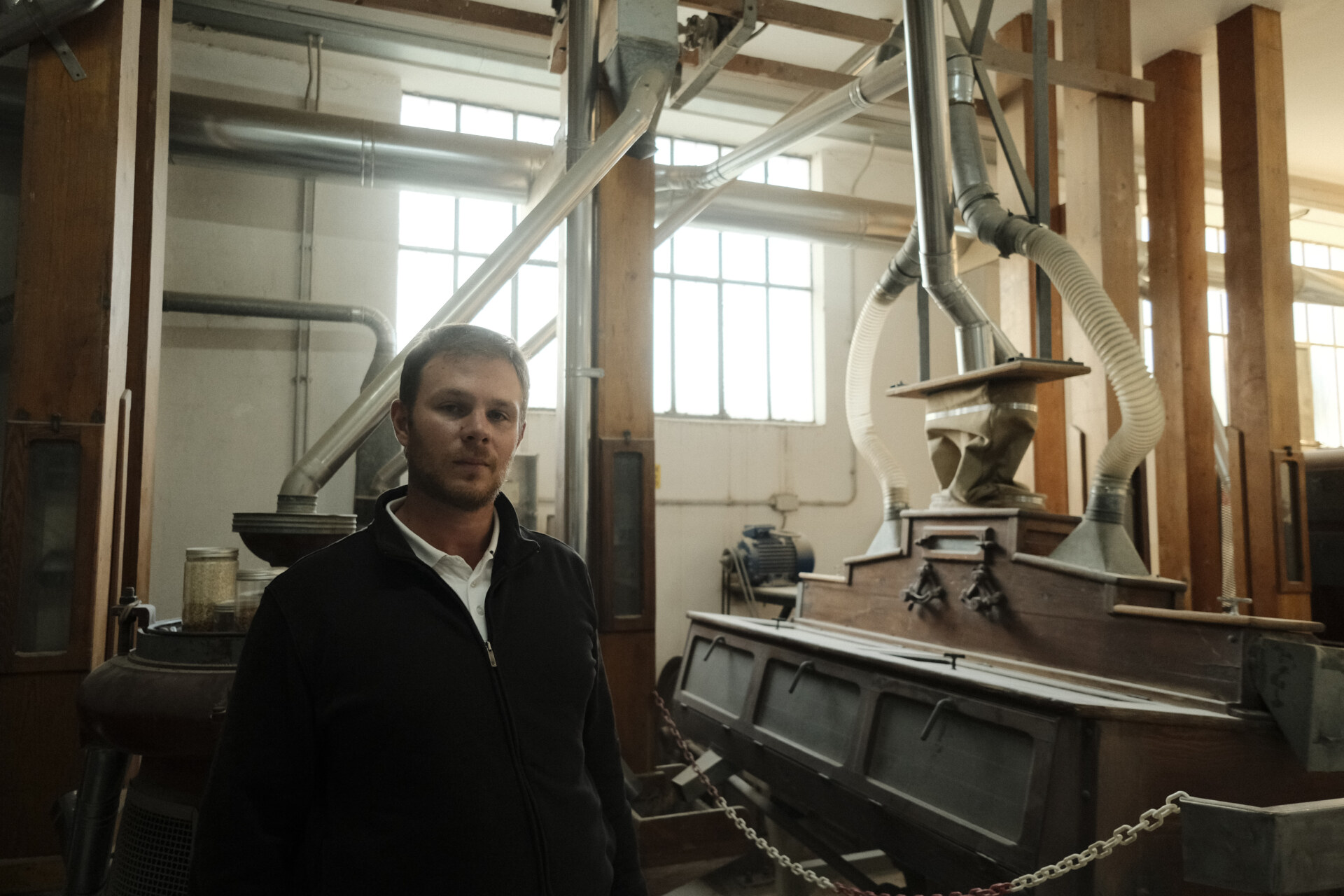
Matteo Tomasoni in his operating risiera (mill)
As dusk approaches at 4 PM, we drive through the fields, noting how much the cultivation of this crop has done to modify the landscape and create its own special ecology: the muddy risaie are full of herons, storks, ibises, and other beautiful birds that, with rising temperatures, have stopped migrating and made the Baraggia Vercellese their home.
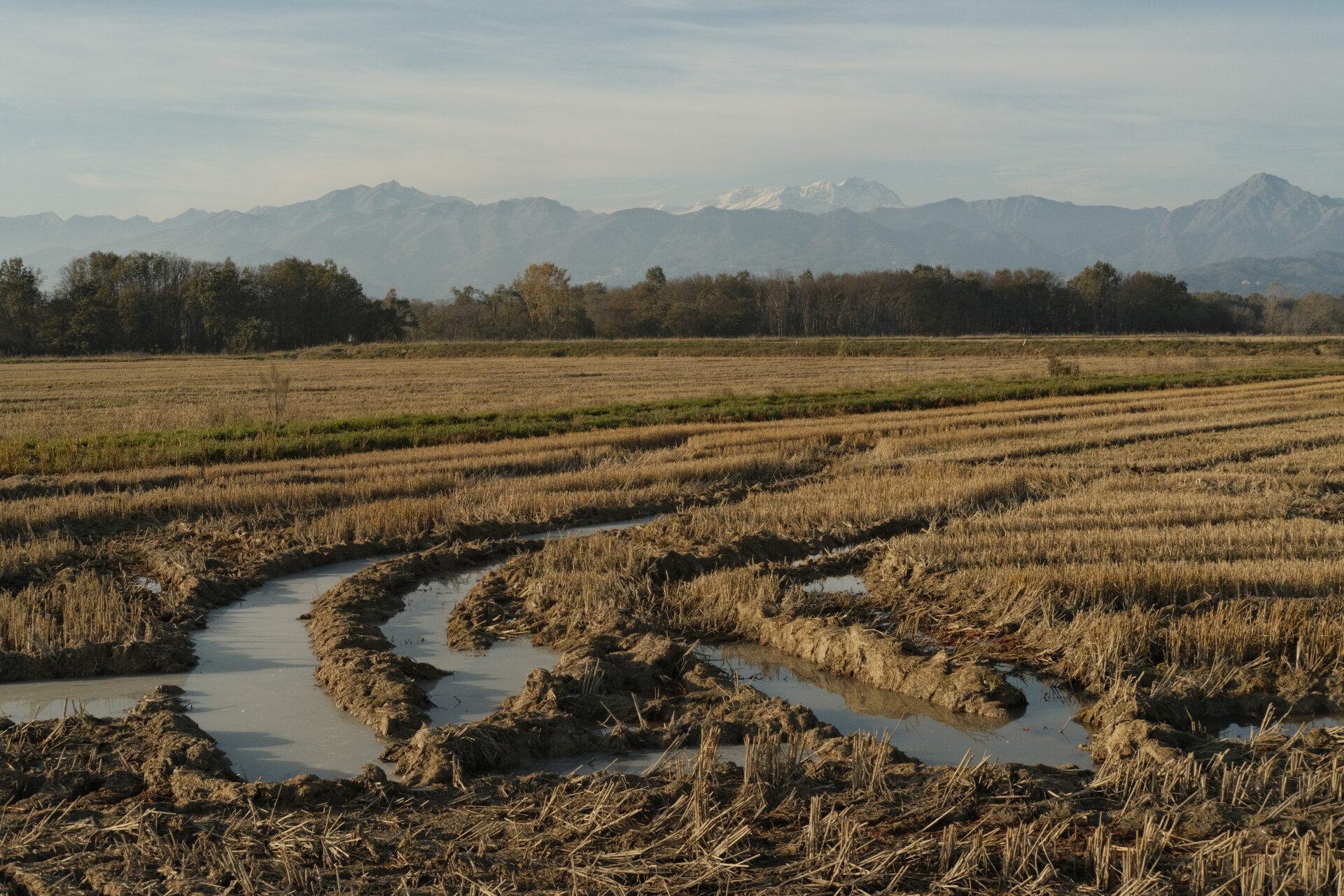
The muddy risaie
In Search of La Panissa
During our visit to OvestSesia–the Camillo Benso Conte di Cavour-founded consortium which manages irrigation on this side of the Po tributary–we ask about panissa to rice sommelier (yes, that’s a thing) Valentina Masotti (43) and the consortium’s spokesperson Ombretta Bertolo (56). Each of them gives us an incredibly in-depth lecture about the different varieties of rice–Valentina’s job is to educate the public, so the diversity and quality of Italian rice is properly recognized–as well as how the irrigation system actually works. When we ask them for a good trattoria that makes panissa, we get the same reaction we did in the days before: not only do they struggle to come up with names, the names they do list are immediately and timidly retracted.
The consensus seems to be that–because it’s a heavy peasant fare that takes a while to cook–the soup is almost impossible to find without ordering in advance, and even so very few follow the proper recipe.
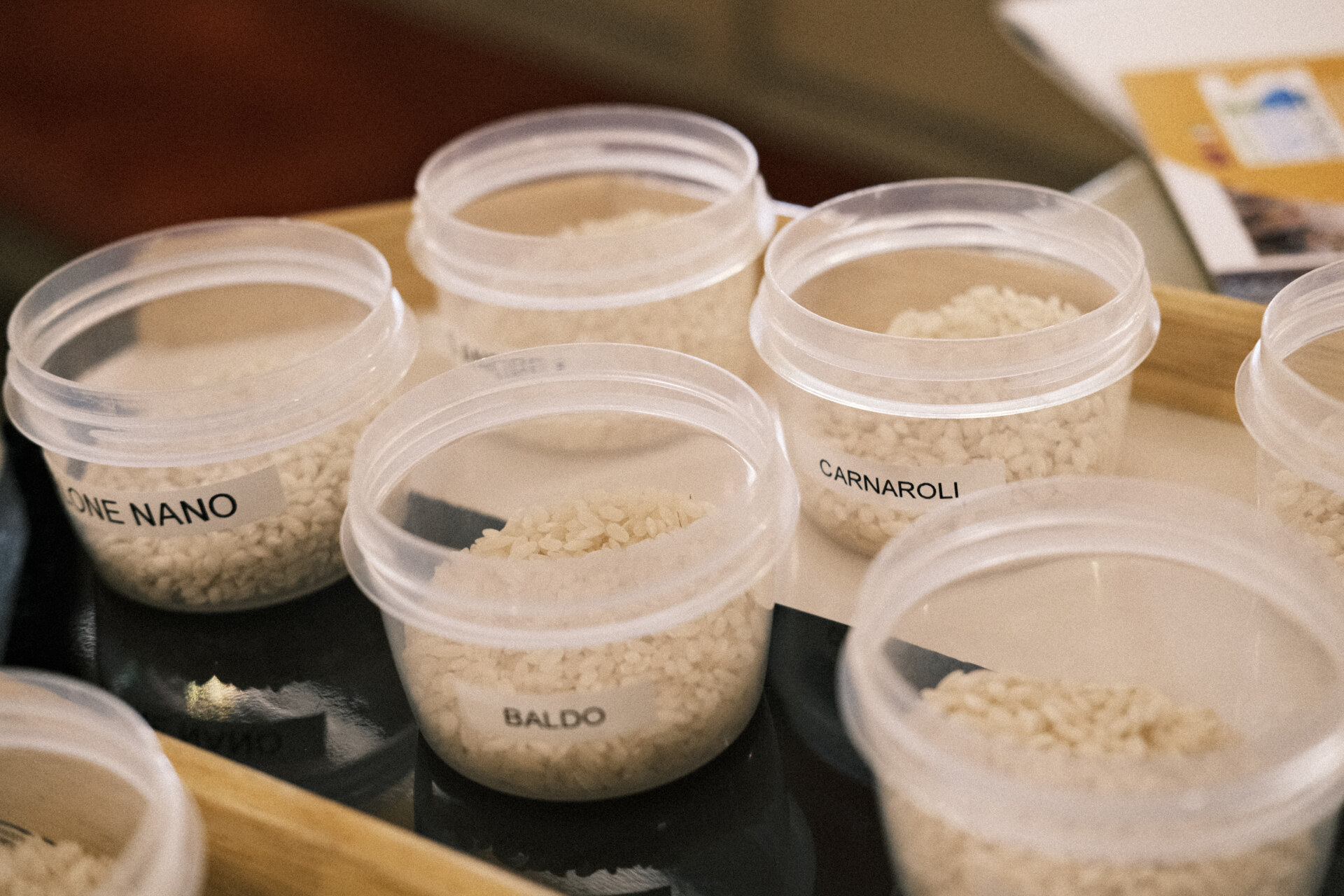
Different varieties of rice
Some point to Michelin-starred restaurant Christian & Manuel (recently featured on Stanley Tucci’s Searching For Italy), which has more than 20 different risotti and a revisited rendition of panissa, but we decide to stick to what we know.
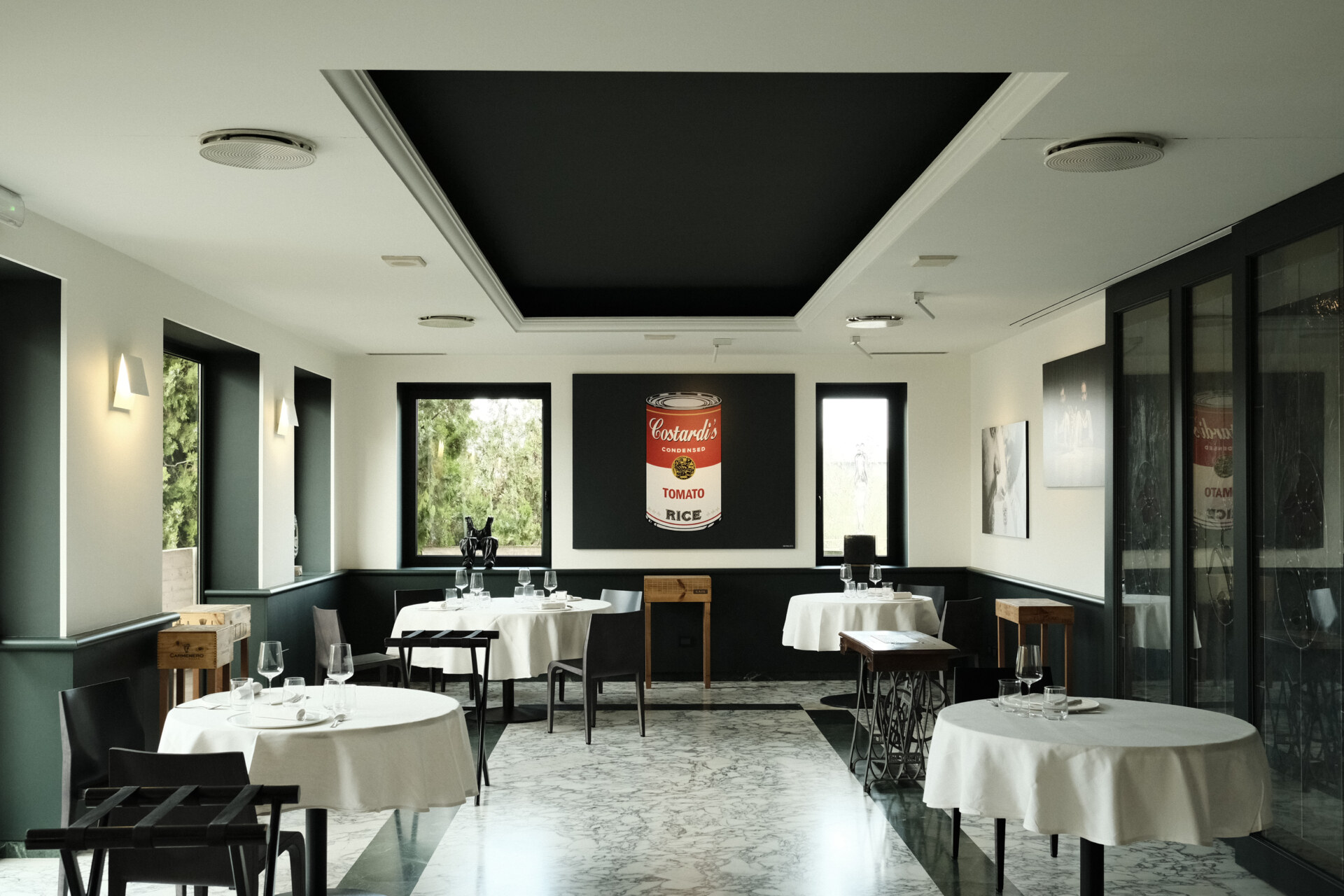
Michelin-starred restaurant Christian & Manuel
We land at a salsamenteria (an alimentari where you can lunch on taglieri and wine, typical of Parma and its thereabouts), a concept as foreign in Vercelli as sushi. (Although this might be another hyperbole since the variety commonly used to make sushi in Europe, Selenio, is also produced here.) Immediately, we spot panissa al salto on the menu, so we ask the waiter–who turns out to be the mother of the owner Laura, who opened La Salsamenteria di Via dei Mercati in 2019–for more information. She says that, in keeping with the humble philosophy of the dish, they make panissa al salto whenever they have leftovers from the previous service. We ask if they’re planning to cook more for the dinner service, and after some convincing, we agree to come back around 6 PM to take some pictures of the preparation.
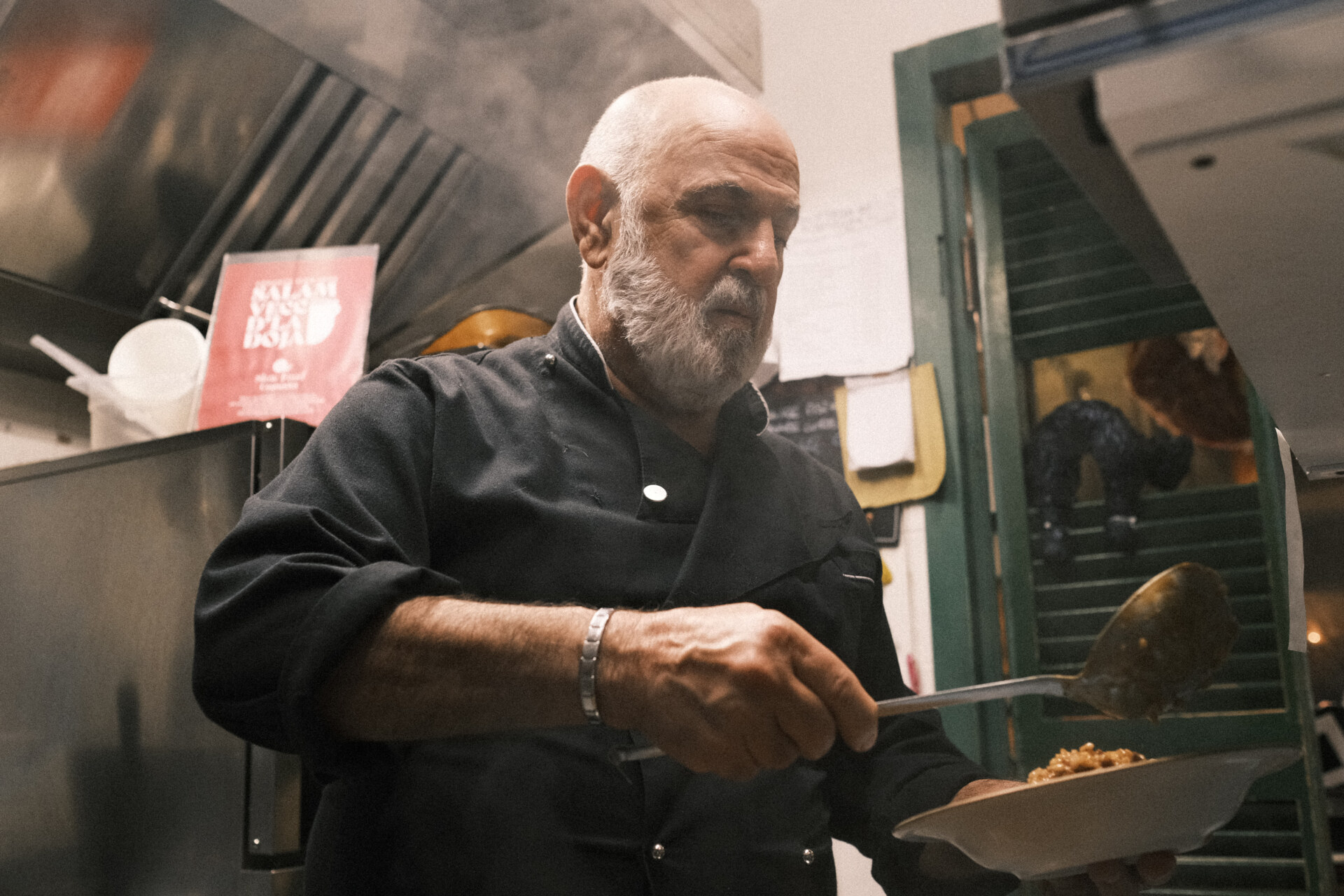
Rito preparing panissa al salto
What we discover far exceeds our expectations. Laura’s passion for food–evident in the top-notch products she sells and the guts to open such an establishment in Vercelli, not exactly a place open to “novelty”–comes directly from her father Rito (66) who, after closing out the family restaurant, still comes in to give a hand and cook panissa himself.
As it turns out, Rito is Sicilian and moved to Vercelli in 1962 when he was just four years old. Over quite a few glasses of Barbera and taglieri, which include the unmissable salame d’la doja, we learn that Rito is amongst the organizers of the new festival Panissa Day, whose objective is to bring the dish back from quasi-oblivion.
“As a teenager, I would come back from the club and would always make pasta for me and my friends.” The passion turned into a job when, at the sports center where he used to coach the local football team, he decided to take over the bar, offering a mix of Sicilian as well as local fare. “It was the best gym,” he says with a hint of nostalgia, reminiscing on the elderly patrons who would never stop criticizing or giving advice on his food. “Right now,” he says, “after much trial and error, I have reached a good point.”
He starts with a soffritto of diced onions, lard, salame d’la doja, and a spoon of concentrato. He adds the rice, cooks until toasted, and then pours over a good glass of a tangy, highly acidic Barbera (important to cut through the richness). He then brings the rice to cottura with the cooking water left over from the fagioli di Saluggia, thickened by a few spoonfuls of beans whizzed together. He adds the rest of the beans at the same time. The result is a thick, dry minestra that feels as creamy as risotto, but that doesn’t need any mantecatura.
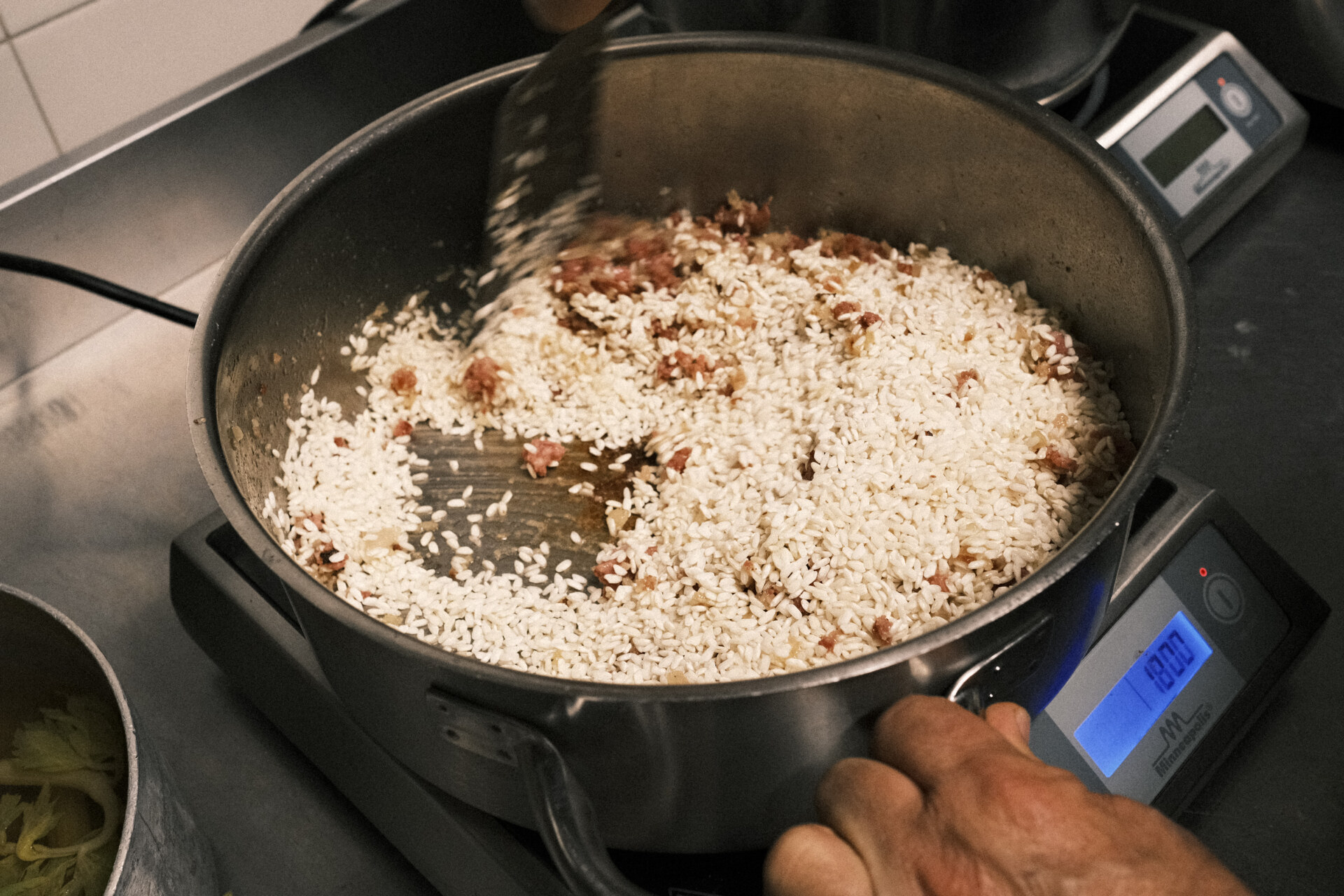
The rice cooks until toasted and doused in a glass of a tangy, highly acidic Barbera
The large pot now resting in the small kitchen is meant for a party of 12 who have expressly ordered it to celebrate a birthday. Still, Rito is still able to sneak us a plate, and soon does the same for a couple of regulars that have sat with us in the meantime.
If this trip has taught us anything, it’s to never romanticize the past; but there is something about these kinds of places that we simply cannot resist. After the panissa, we stay for a chat and a few more glasses of wine followed by one last grappa with Rito and Laura. Soon we will be driving back to Milan, but whenever the craving for panissa strikes, we know where to go.


